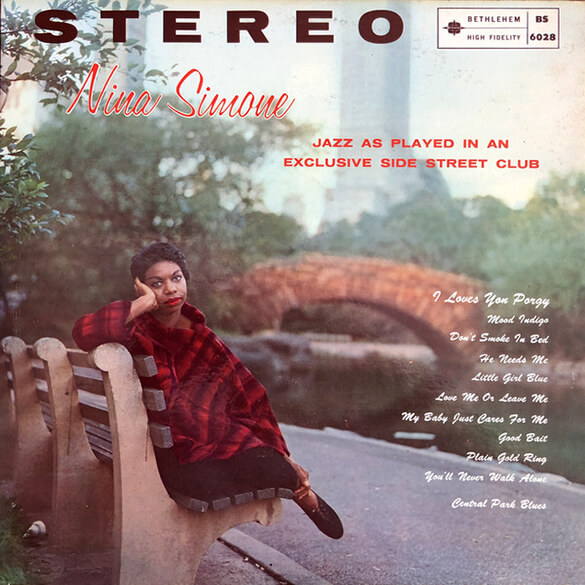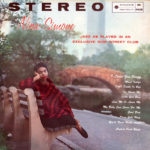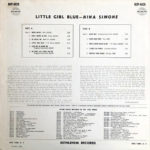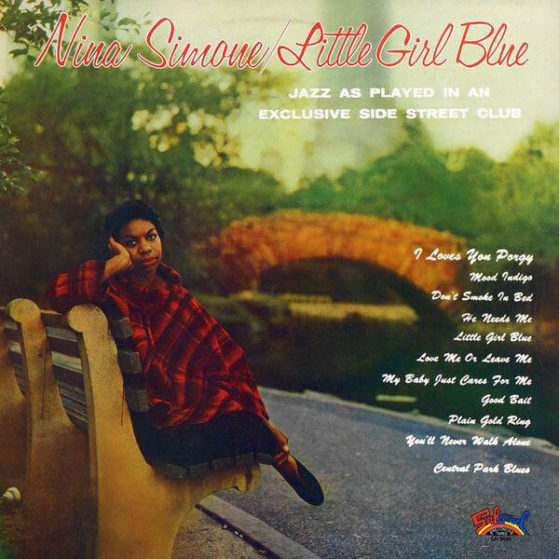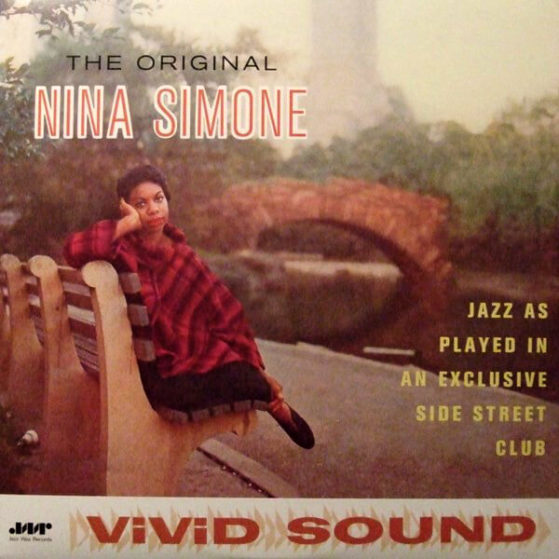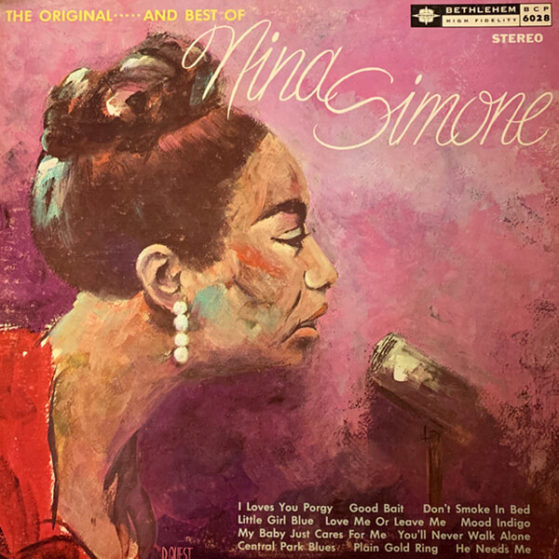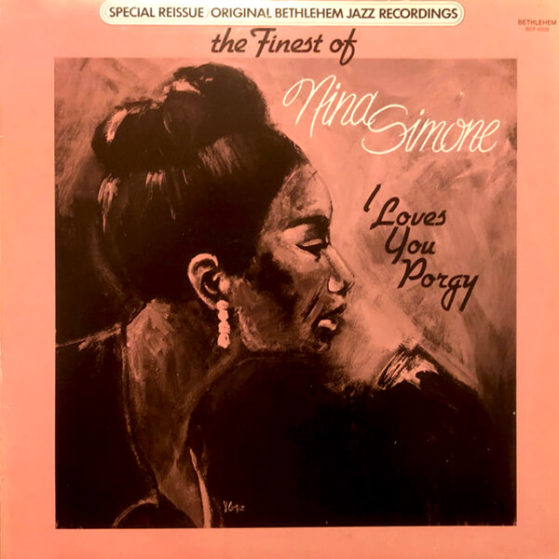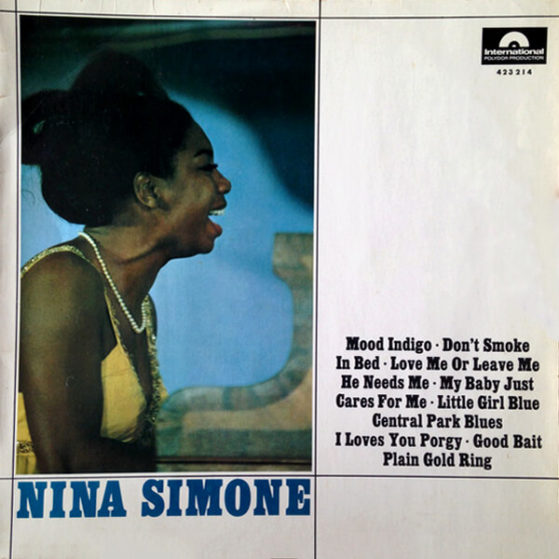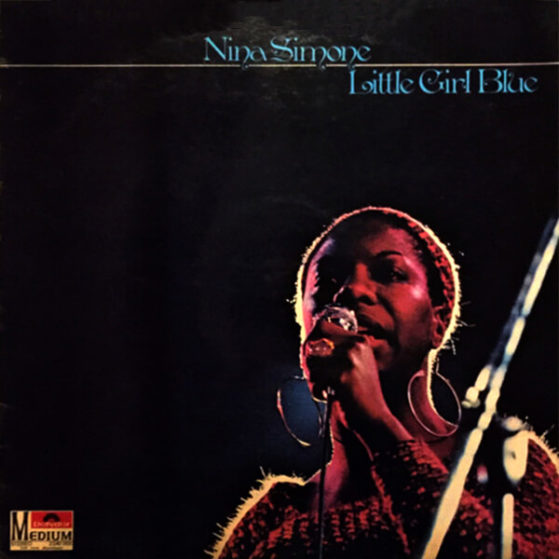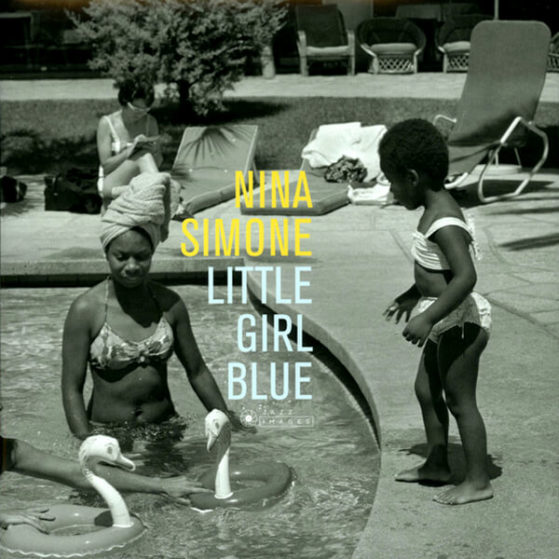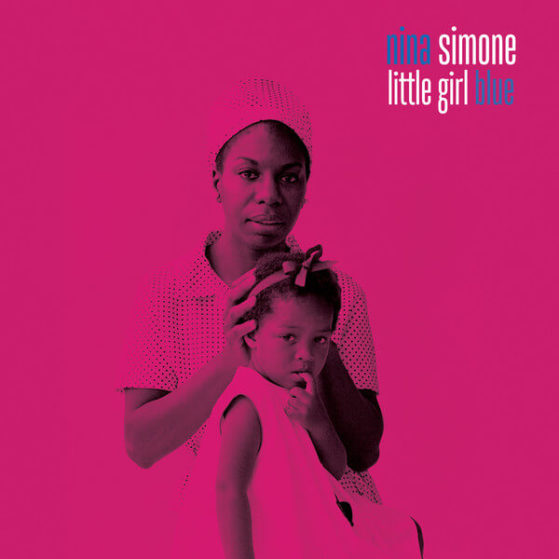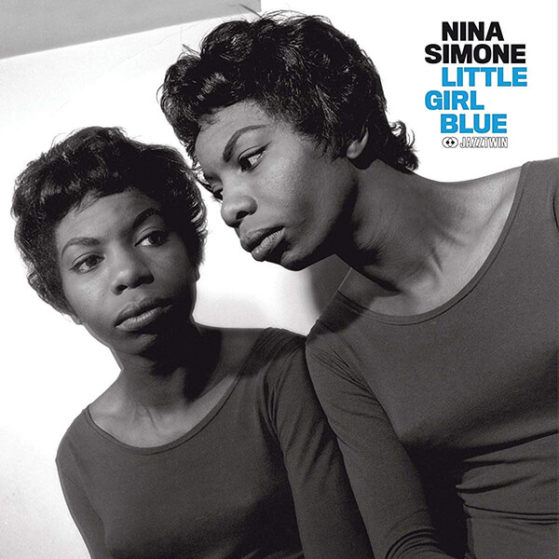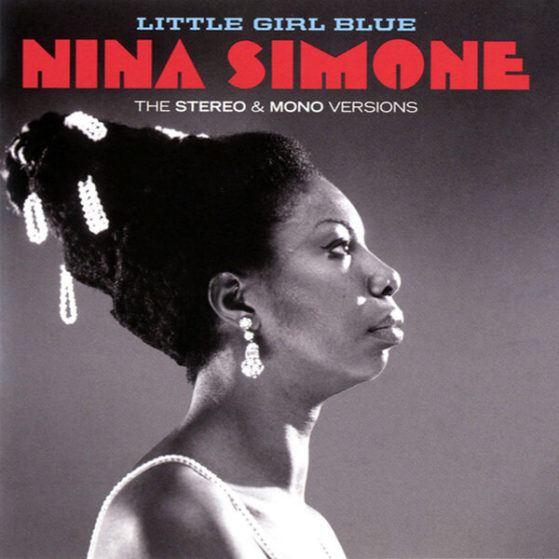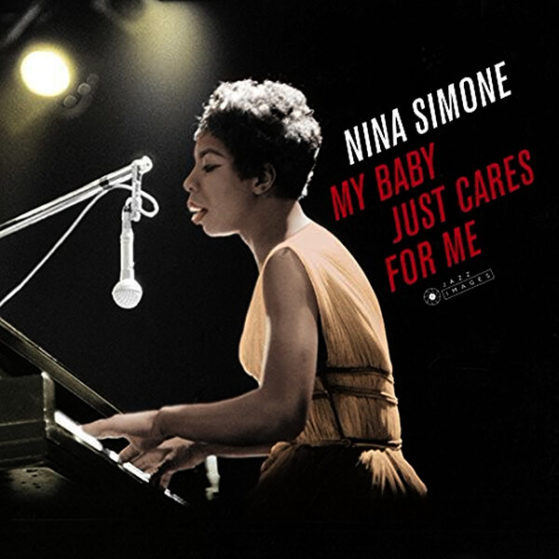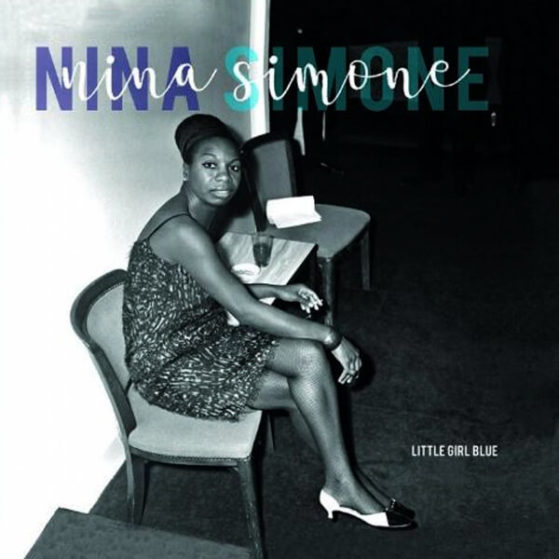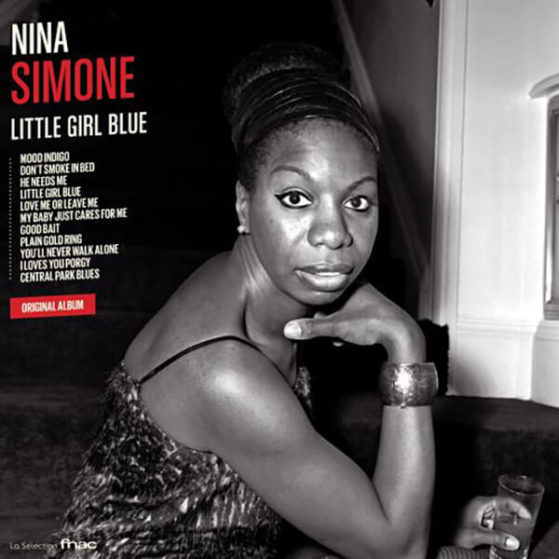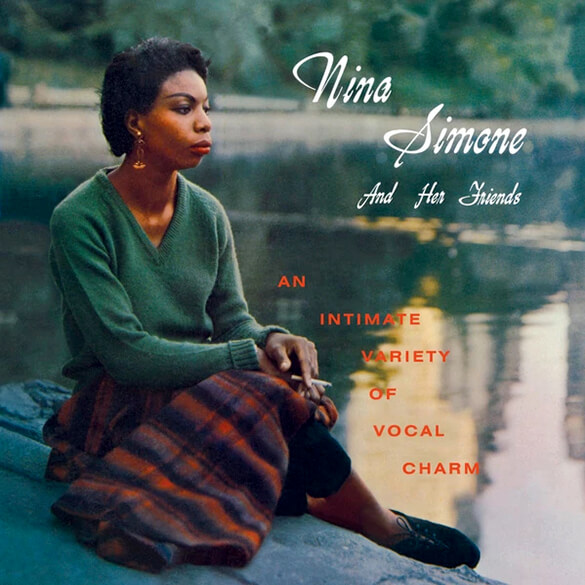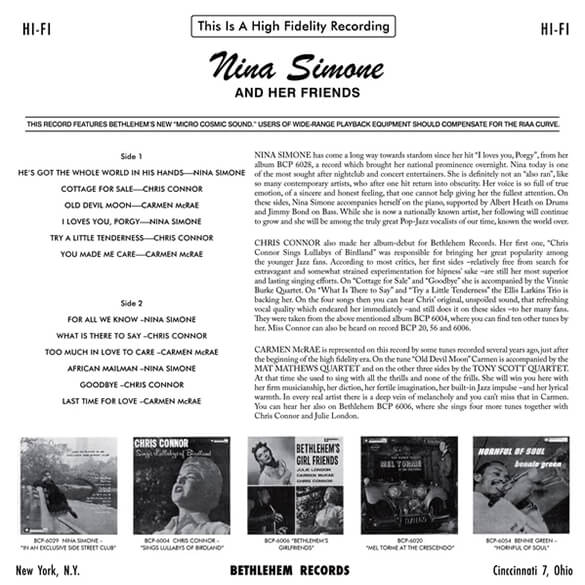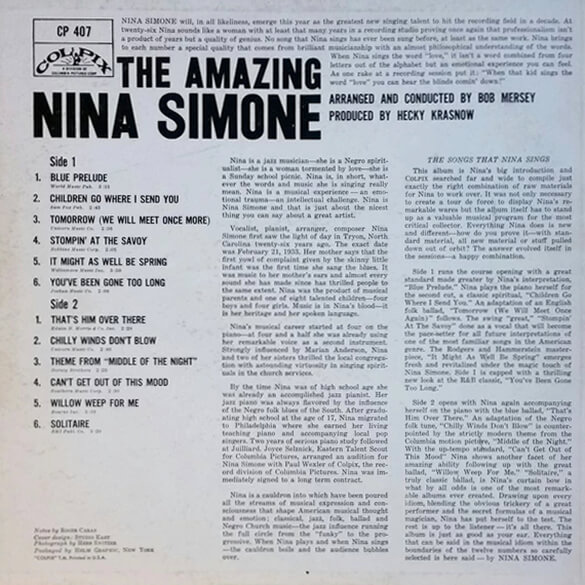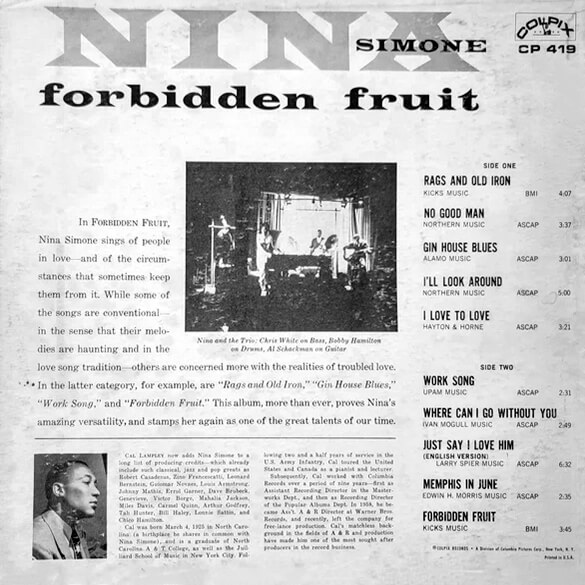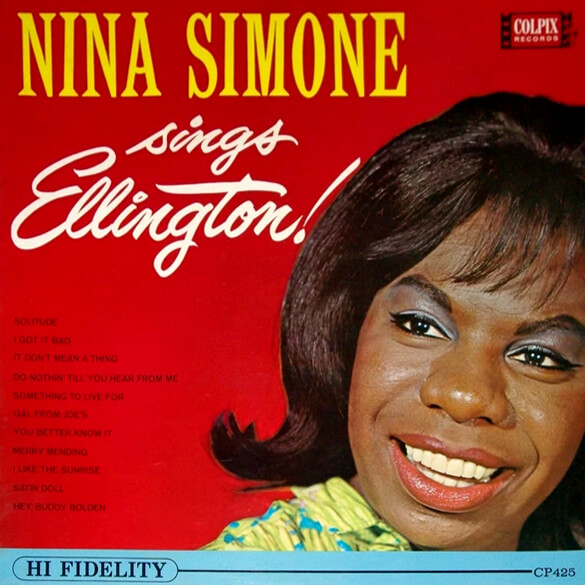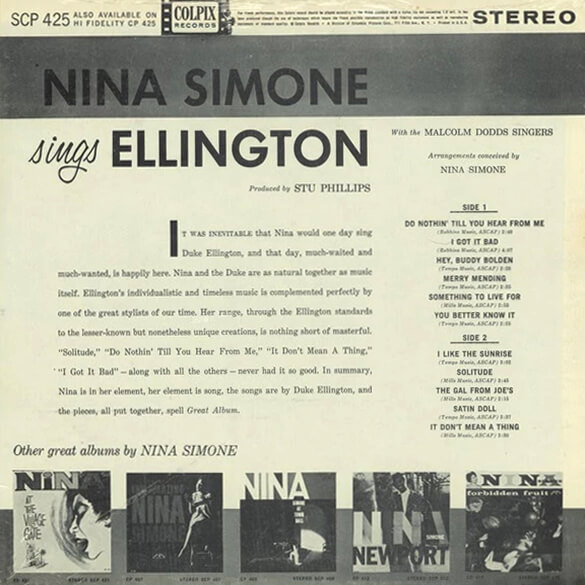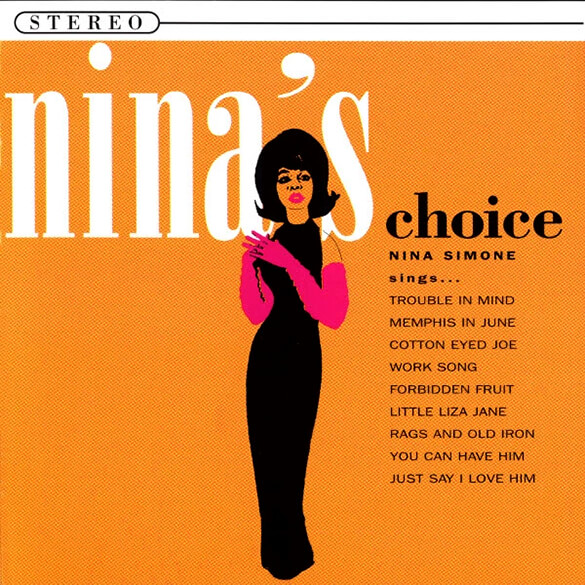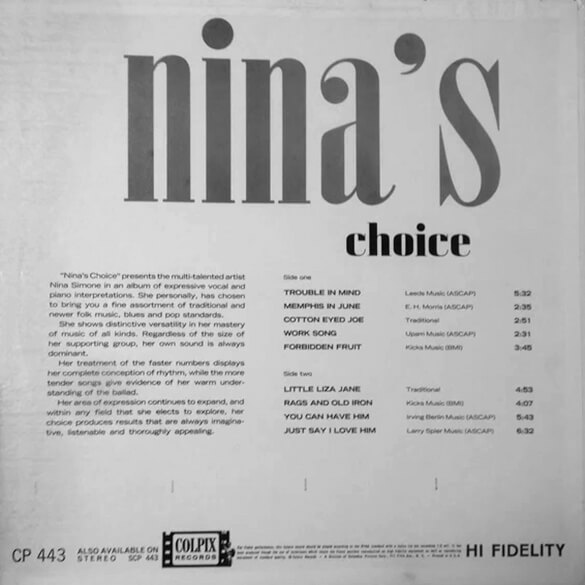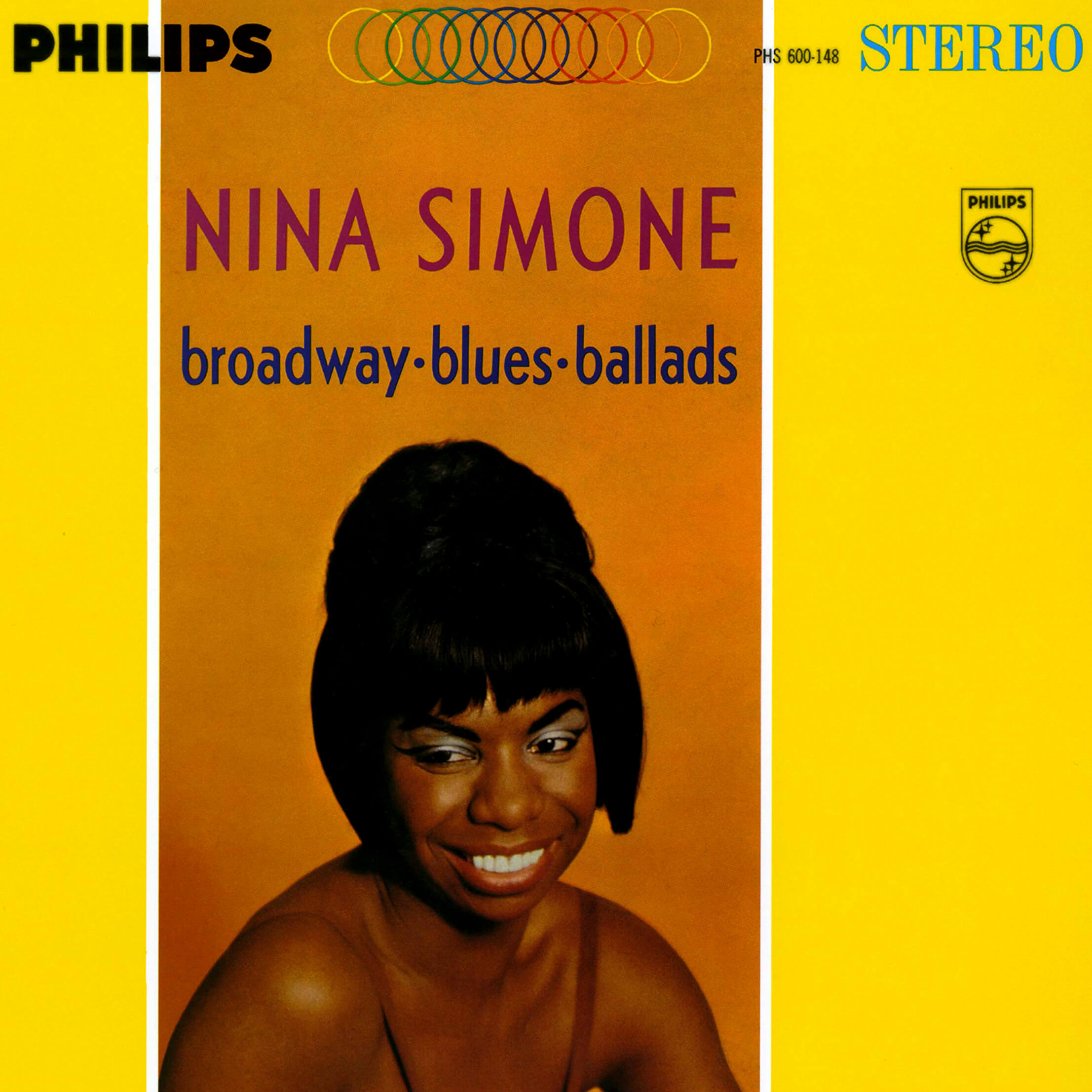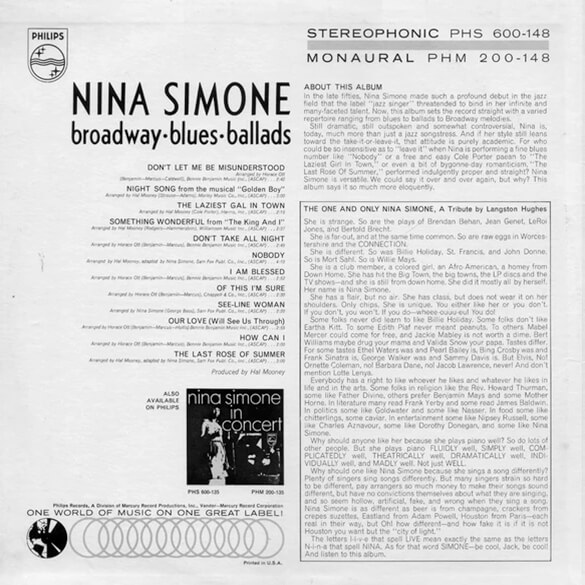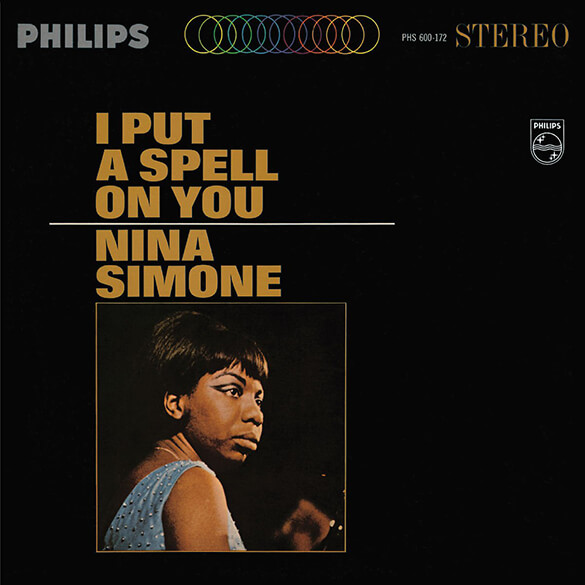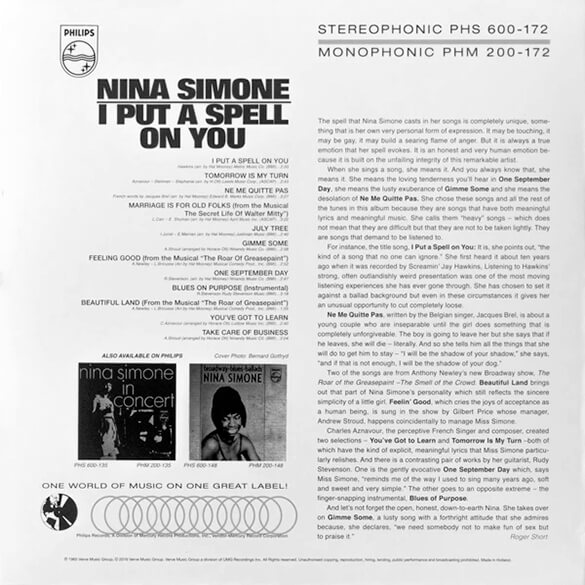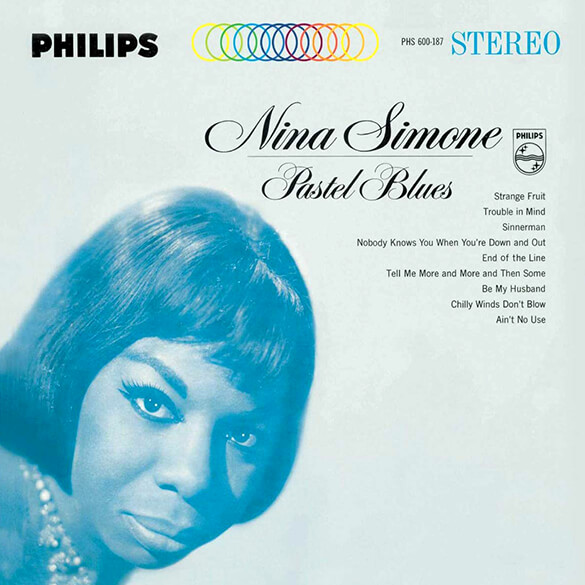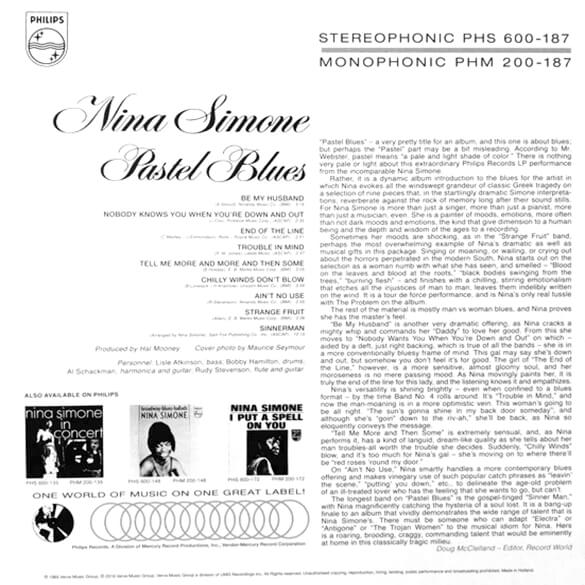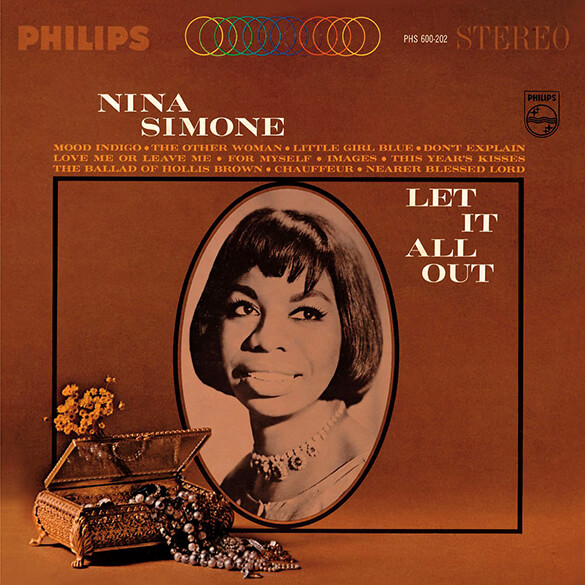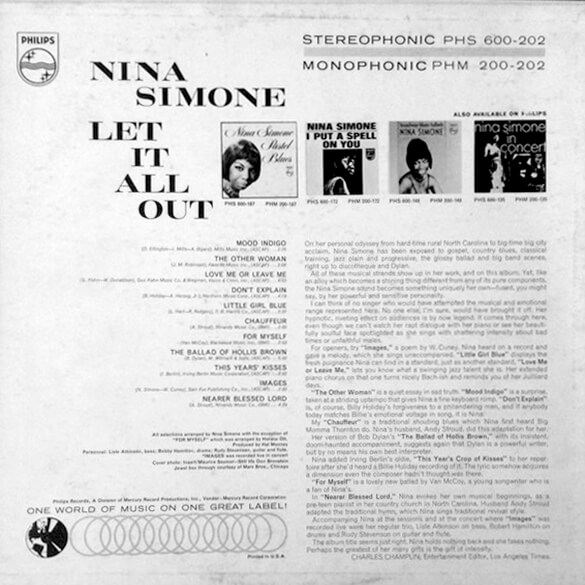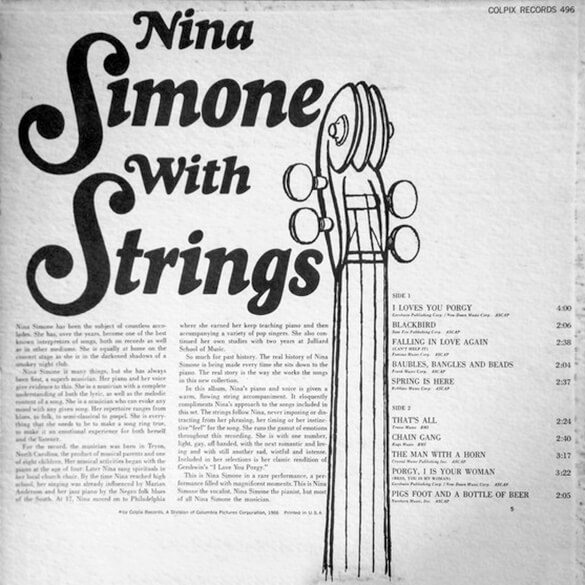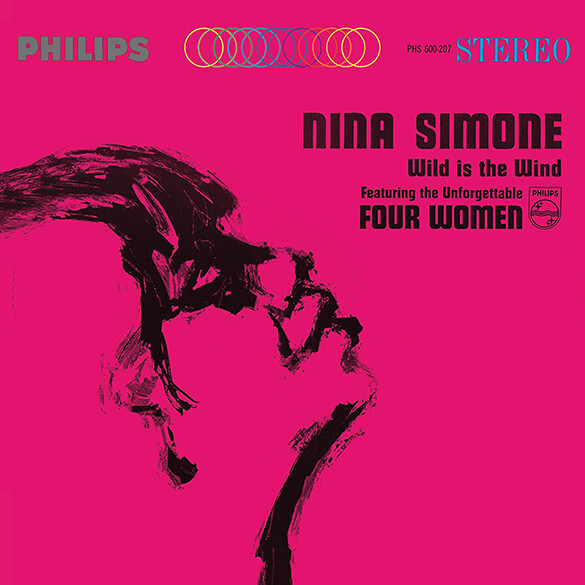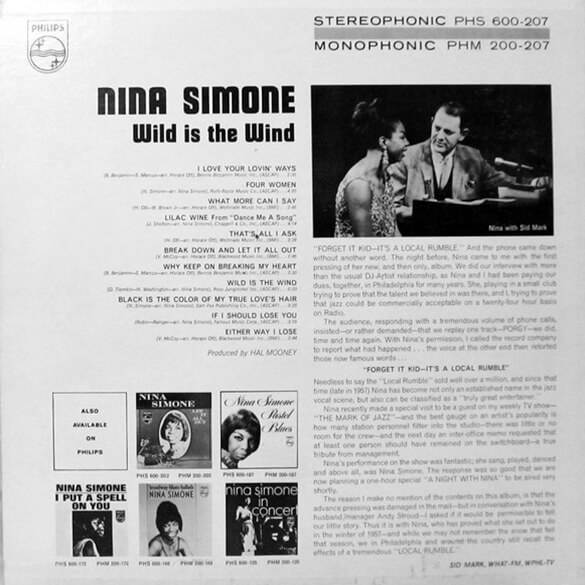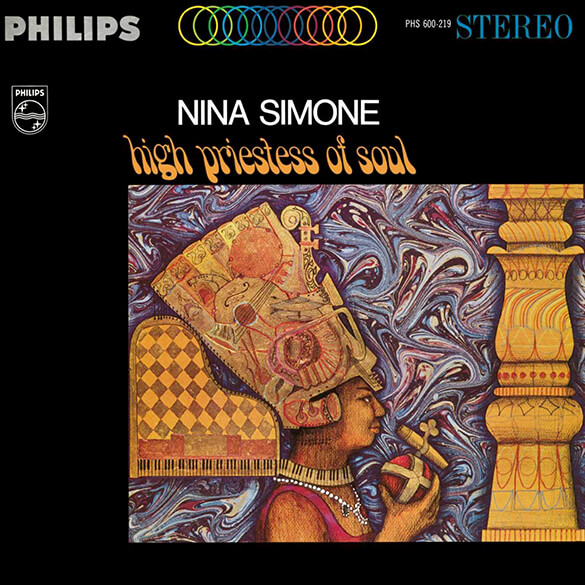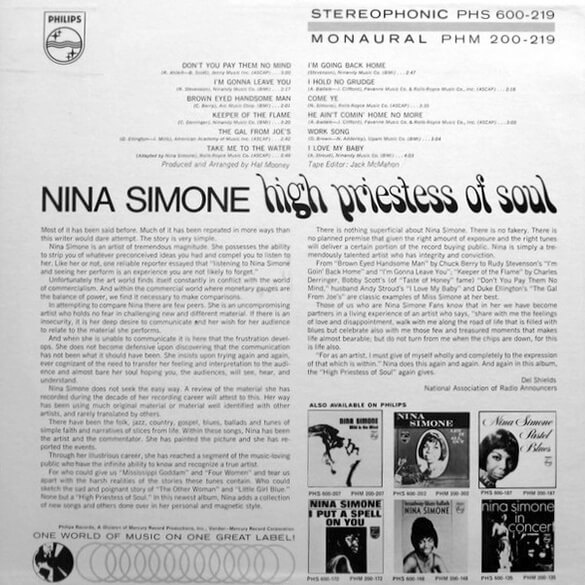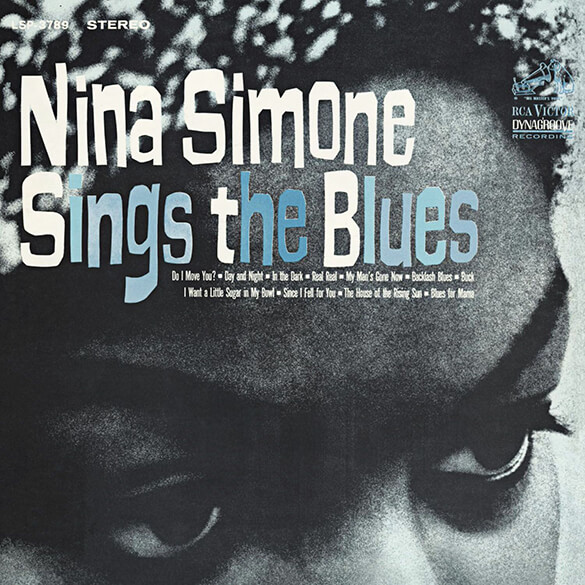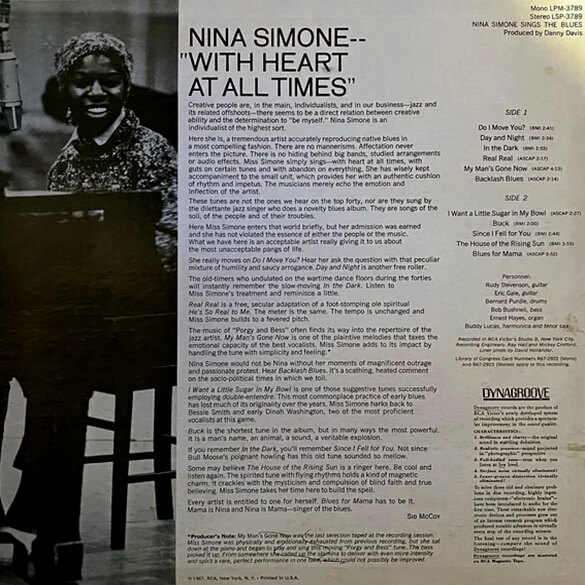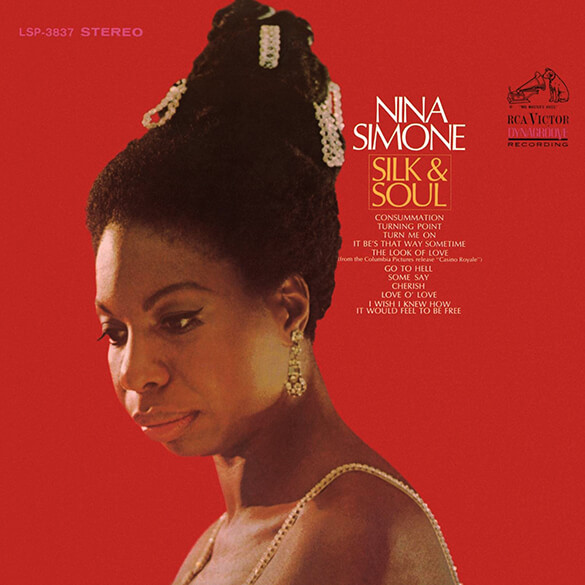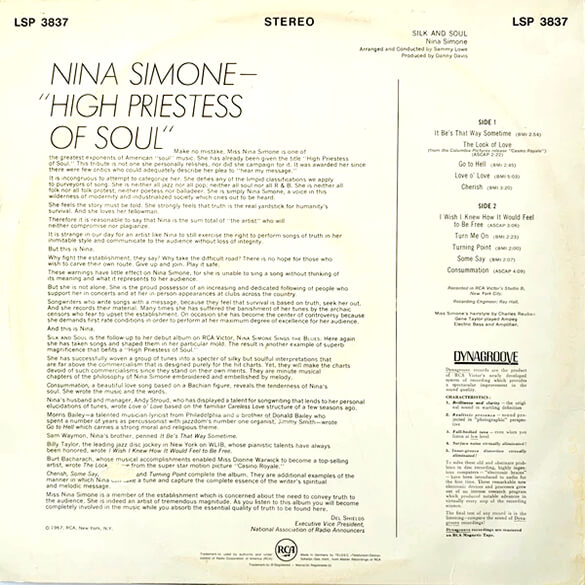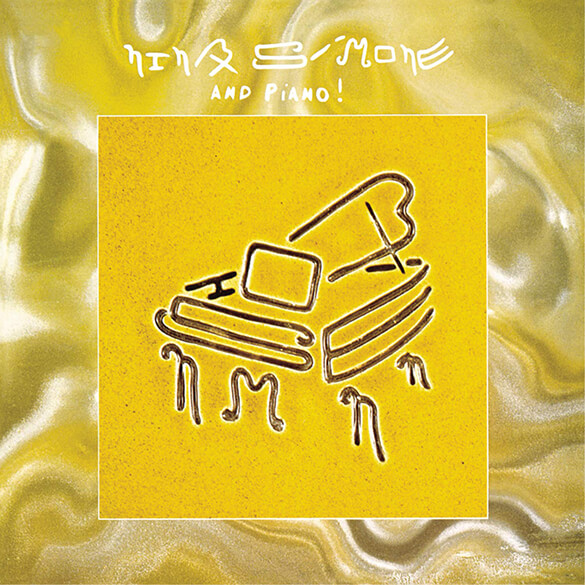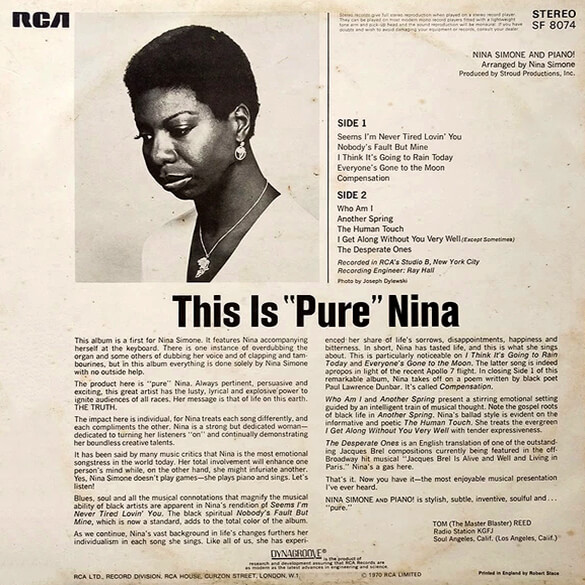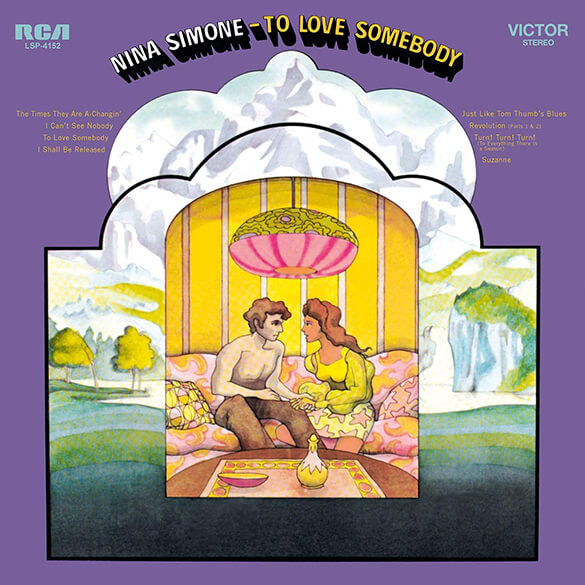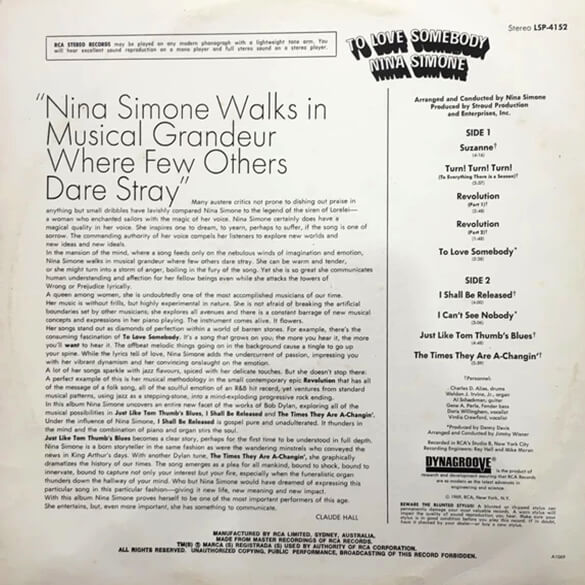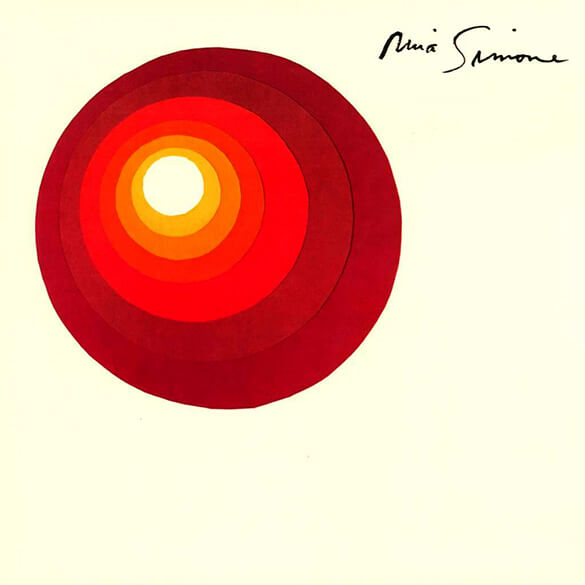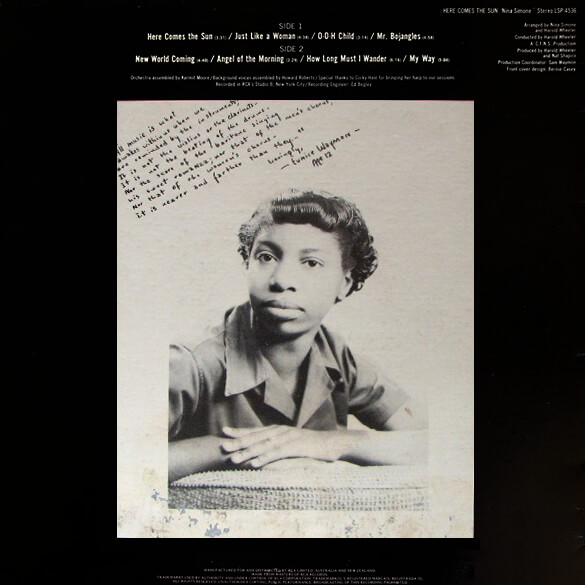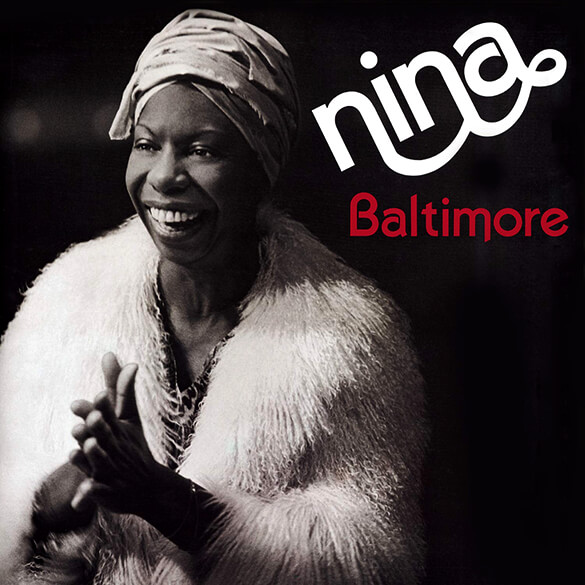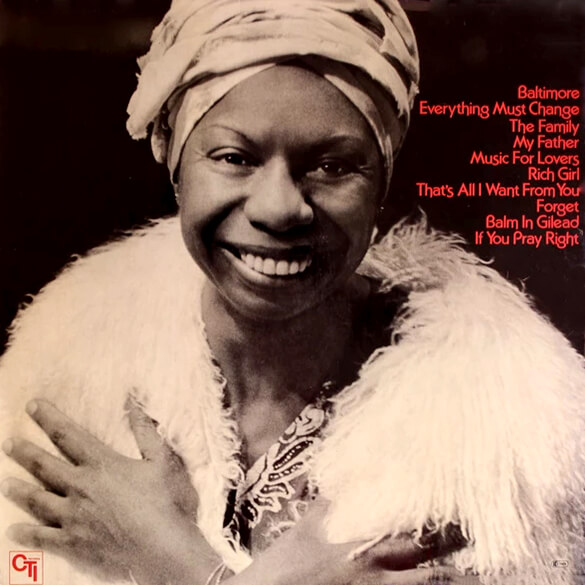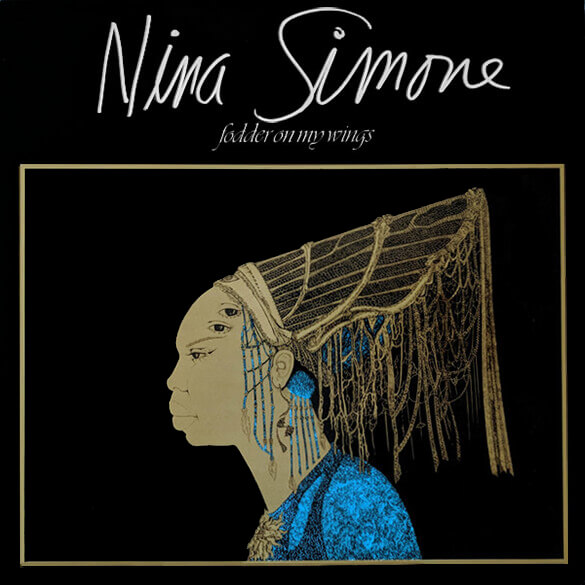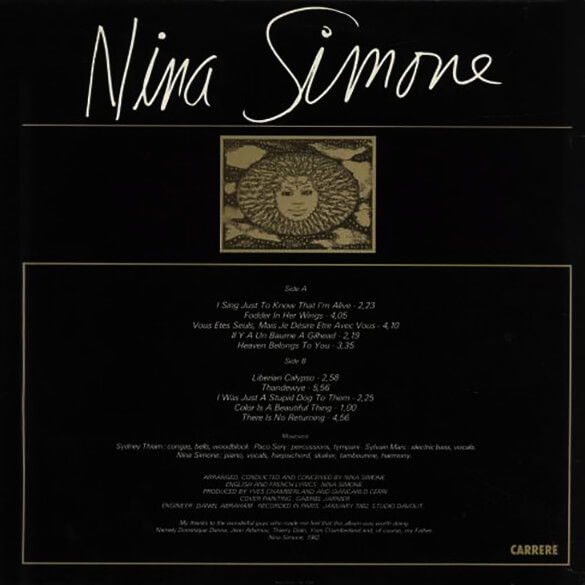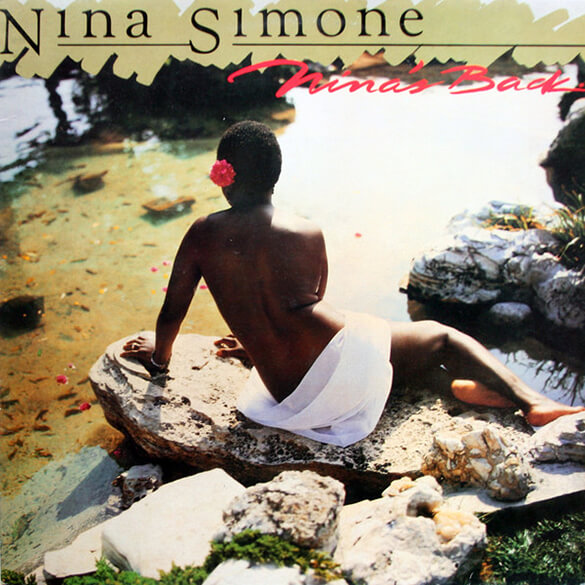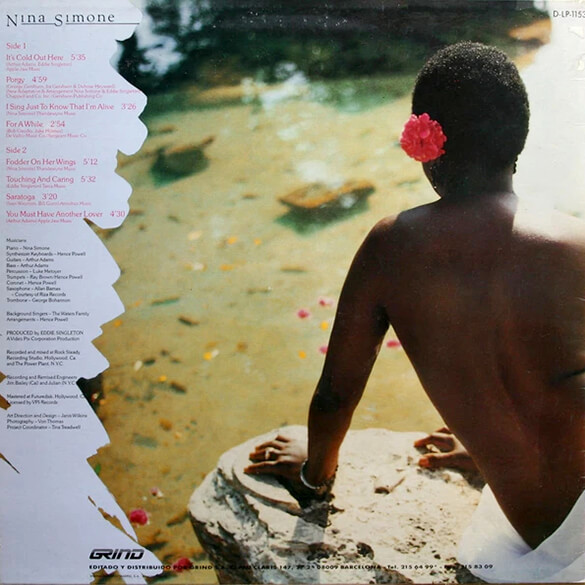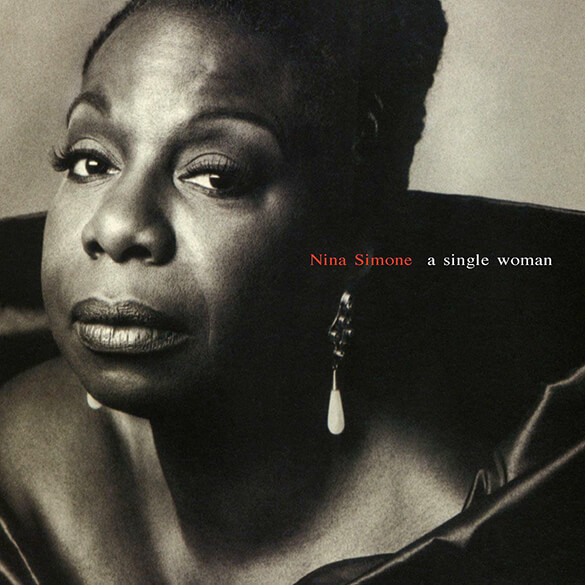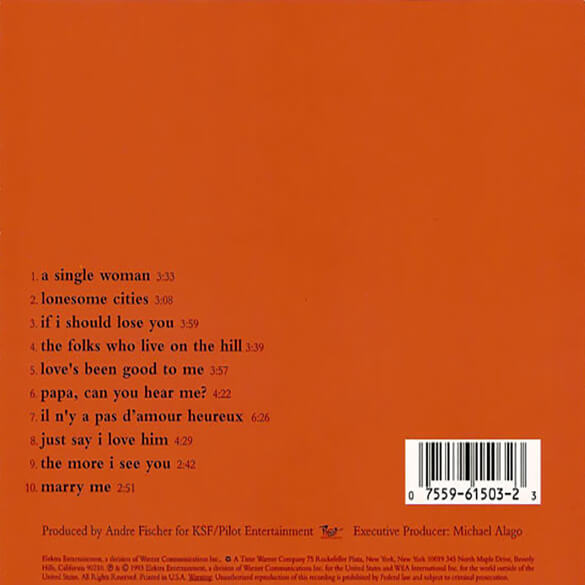- Mood Indigo
- Don’t Smoke In Bed
- He Needs Me
- Little Girl Blue
- Love Me Or Leave Me
- My Baby Just Cares For Me
- Good Bait (Instrumental)
- Plain Gold Ring
- You’ll Never Walk Alone
- I Loves You, Porgy
- Central Park Blues
- Nina Simone – vocals, piano, arrangements
- Jimmy Bond – double bass
- Albert “Tootie” Heath – drums
- Joseph Muranyi – liner notes
- Chuck Stewart – photography
Recording session: Beltone Studios – New York City – December 1957
Catalog number: BS-6028 / BCP-6028
A rare commodity in jazz is a new singer who has something different to say and sufficient technique and voice with which to express it. There are plenty of musical singers who vocalize well and have an individual style but who never cross that thin and hard-to-define line that separates a good “pop” style from one that is jazz.
Nina Simone’s first few notes will immediately tell you into which camp she falls. It’s always pleasant to hear a good voice and hers, with its strong individuality, assuredly commands your attention while the aural reward for listening is bountiful. Nina’s musical philosophy regarding her singing is to-the-point enough to be stated in one telling statement — “You got to get to people”. That she does with a vibrant and husky contralto that tonally sounds like a blend of an unlikely combination of Marian Anderson and Ma Rainey.
Nina is throughly schooled in music and she plays the piano, vocalizes, arranges, and composes. Her talents are well represented in this set as she plays all of the piano, does all the singing, has arrange all of the songs and has composed the rhythmic “Central Park Blues”. Her accompaniment, besides her own piano, consists of the sensitive assistance of Jimmy Bond, bass and Al Heath, drums (brother of Percy). Her approach to a performance stems from her above-expressed feeling on the subject; she sets the mood with her piano, quite often at extended length and then she enters, in the same mood, with her voice. A good example of this is her version of “Little Girl Blue”. Her interpolation of the Christmas carol, “Good King Wenceslas” as a counter-melody has aroused admiration wherever she has played it.
Nina Simone was born 25 years ago — the exact date is February 21, 1933 — in the town of Tryon, North Carolina. She was one of eight children; four boys, four girls who all sing or play an instrument; perhaps this steams from the fact that her parents are also quite musical. At four she started to play piano, by four and a half she was singing.
Soon the local church rang with the voices of a girl trio composed of the Simone girls (including Nina). In this period she especially liked and was much impressed by Marian Anderson, the great contralto. By the time she reached high school she was playing jazz piano heavily tinged with the the folk blues of the south.
When she graduated at 17, she left home for Philadelphia, Pa. Here she continued her piano studies and made a living by teaching piano and accompanying vocal students of the popular idiom. Two years of serious piano studies were taken at this time at New York’s Juilliard School of Music. After four years of accompanying others she had the yen to sing and give vent to her long subdued vocal talents. Soon she made her first vocal appearance, singing from the keyboard, at the Mid-Town Club in Atlantic City. By this time she had heard and enjoyed (and perhaps been influenced by) such stylists as Louis Armstrong, Kitty White, Sarah Vaughn, Louis Jordan and Billie Holiday.
When it comes to instrumental jazz, she likes the modern sounds of groups like Chico Hamilton. In her words — “I guess I like the progressive sounds ’cause my training was classical.”
To sum up Nina Simone’s style is difficult but a listing of what makes her unique is perhaps easier. Her unusual combination of classical training, the ecstatic and serious quality of negro church music which has influenced her vocal delivery and the “funky” and modern schools of jazz with which she has come into close contact all make for a novel and often inspiring jazz singer and instrumentalist.
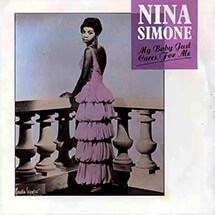
MY BABY JUST CARES FOR ME (1987)
Additions: My Baby Just Cares For Me (Special Extended Version)
- He’s Got The Whole World In His Hands
- I Loves You, Porgy
- For All We Know
- African Mailman
- Nina Simone – vocals, piano, arrangements
- Jimmy Bond – double bass
- Albert “Tootie” Heath – drums
- Chuck Stewart – photography
Recording session: New York City – December 1957
Catalog numer: BCP-6041
Liner notes:
Nina Simone has come a long way towards stardom since her hit “I Loves You, Porgy”, from her album BCP 6028, a record which brought her national prominence overnight. Nina today is one of the most sought after nightclub and concert entertainers.
She is definitely not an “also ran”, like so many contemporary artists, who after one hit return into obscurity. Her voice is so full of true emotion, of a sincere and honest feeling, that one cannot help giving her the fullest attention.
On these sides Nina Simone accompanies herself on the piano, supported by Albert Heath on Drums and Jimmy Bond on Bass.
While she is now a nationally known artist, her following will continue to grow and she will be among the truly great Pop-Jazz vocalists of our time, known the world over.
ALTERNATE COVERS:

- Blue Prelude
- Children Go Where I Send You
- Tomorrow (We Will Meet Once More)
- Stompin’ At The Savoy
- It Might As Well Be Spring
- You’ve Been Gone Too Long
- That’s Him Over There
- Chilly Winds Don’t Blow
- Theme From ‘Middle of the Night’
- Can’t Get Out Of This Mood
- Willow Weep For Me
- Solitaire
- Nina Simone – vocals, piano, arrangements
- Bob Mersey – arrangement, conductor
- Hecky Krasnow – producer
- Roger Caras – liner notes
- Herb Snitzer – photography
Recording session: Van Gelder Studio – Hackensack, New Jersey – 1959
Catalog number: CP 407 / SCP 407
Liner notes:
Nina Simone will, in all likeliness, emerge this year as the greatest new singing talent to hit the recording field in a decade. At twenty-six Nina sounds like a woman with at least that many years in a recording studio proving once again that professionalism isn’t a product of years but a quality of genius. No song that Nina sings has ever been sung before, at least as the same work. Nina brings to each number a special quality that comes from brilliant musicianship with an almost philosophical understanding of the words. When Nina sings the word “love,” it isn’t a word combined from four letters out of the alphabet but an emotional experience you can feel. As one rake at a recording session put it: “When that kid sings the word “love” you can hear the blinds comin’ down!”
Nina is a jazz musician–she is a negro spiritualists–she is a woman tormented by love–she is a Sunday school picnic. Nina is, in short, whatever the words and the music she is singing really mean. Nina is a musical experience–an emotional trauma–an intellectual challenge. Nina is Nina Simone and that is just about the nicest thing you can say about a great artist.
Vocalist, pianist, arranger, composer, Nina Simone first saw the light of day in Tryon, North Carolina twenty-six years ago. The exact date was February 21, 1933. Her mother says that the first yowl of complaint given by the skinny little infant was the first time she sang the blues. It was music to her mother’s ears and almost every sound she has made since has trilled people to the same extent. Nina was the product of musical parents and one of eight talented children–four boys and four girls. Music is in Nina’s blood–it is her heritage and her spoken language.
Nina’s musical career started at four on the piano–at four and a half she was already using her remarkable voice as a second instrument. Strongly influenced by Marian Anderson, Nina and two of her sisters thrilled the local congregation with astounding virtuosity in singing spirituals in the church services.
By the time Nina was of high school age she was already an accomplished jazz pianist. Her jazz piano was always flavored by the influence of the Negro folks blues of the South. After graduating high school at the age of 17, Nina migrated to Philadelphia where she earned her living teaching piano and accompanying local pop singers. Two years of serious piano study followed at Juilliard. Joyce Selznick, Eastern Talent Scout for Columbia Pictures, arranged an audition for Nina Simone with Paul Wexler of Colpix, the record division of Columbia Pictures. Nina was immediately signed to a long term contract.
Nina is a cauldron into which have been poured all the streams of musical expression and consciousness that shape American musical thought and emotion; classical, jazz, folk, ballad and Negro Church music–the jazz influence running the full circle from the “funky” to the progressive. When Nina plays and when Nina sings–the cauldron boils and the audience bubbles over.
The songs that Nina sings:
This album is Nina’s big introduction and Colpix searched far and wide to compile just exactly the right combination of raw materials for Nina to work over. It was not only necessary to create a tour de force to display Nina’s remarkable wares but the album itself has to stand up as a valuable musical program for the most critical collector. Everything Nina does is new and different–how do you prove it–with standard material, all new material or stuff pulled down out of orbit? The answer evolved itself in the sessions–a happy combination.
Side 1 runs the course opening with a great standard made greater by Nina’s interpretation, “Blue Prelude.” Nina plays the piano herself for the second cut, a classic spiritual, “Children Go Where I Send You.” An adaptation of an English folk ballad, “Tomorrow (We Will Meet Once Again) follows. The swing “great,” “Stompin’ At The Savoy” done as a vocal that will become the pace-setter for all future interpretations of one of the most familiar songs in the American genre. The Rodgers and Hammerstein masterpiece, “It Might As Well Be Spring” emerges fresh and revitalized under the magic touch of Nina Simone. Side I is capped with a thrilling new look at the R&B classic, “You’ve Been Gone Too Long.”
Side 2 opens with Nina again accompanying herself on the piano with the blue ballad, “That’s Him Over There.” An adaptation of the Negro folk tune, “Chilly Winds Don’t Blow” is counterpointed by the strictly modern theme from the Columbia motion picture, “Middle of the Night.” With the up-tempo standard, “Can’t Get Out of This Mood” Nina shows another facet of her amazing ability following up with the great ballad, “Willow Weep For Me.” “Solitaire”, a truly classic ballad, is Nina’s curtain bow in what by all odds is one of the most remarkable albums ever created. Drawing upon every idiom, blending the obvious trickery of a great performer and the secret formulas of a musical magician, Nina has put herself to the test. The rest is up to the listener–it’s all there. This album is just as good as you ear. Everything that can be said in the musical idiom within the boundaries of the twelve numbers so carefully selected is here said–by Nina Simone.
ALTERNATE COVERS:

EXPANDED EDITIONS:
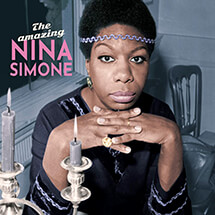
THE AMAZING NINA SIMONE (2020)
Additions: I Loves You, Porgy; Falling In Love Again; That's All; The Man With A Horn; Since My Love Has Gone; If Only For Tonight; Nobody Knows You When You're Down and Out; Come On Back, Jack; I Love To Love (Live); My Baby Just Cares For Me
- Rags and Old Iron
- No Good Man
- Gin House Blues
- I’ll Look Around
- I Love To Love
- Work Song
- Where Can I Go Without You
- Just Say I Love Him
- Memphis In June
- Forbidden Fruit
- Nina Simone – vocals, piano
- Al Schackman – guitar
- Chris White – bass
- Bobby Hamilton – drums
- Carl Lampley – producer
Recording session: New York City – 1960-1961
Catalog number: CP 419 / SCP 419
Liner notes:
In Forbidden Fruit, Nina Simone sings of people in love — and of the circumstances that sometimes keep them from it.
While some of the songs are conventional—in the sense that their melodies are haunting and in the love song tradition—others are concerned more with the realities of troubled love.
In the latter category, for example, are “Rags and Old Iron,” “Gin House Blues,” “Work Song,” and “Forbidden Fruit.” This album, more than ever, proves Nina’s amazing versatility, and stamps her again as one of the great talents of our time.
ALTERNATE COVERS:

EXPANDED EDITIONS:
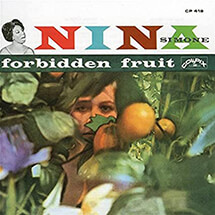
FORBIDDEN FRUIT (2005)
Additions: Porgy I Is Your Woman Now; Baubles Bangles and Beads; Gimme A Pigfoot and a Bottle of Beer; Ev'rytime We Say Goodbye; Spring Is Here; Lonesome Valley; Golden Earrings; My Ship; 'Taint Nobody's Biz-ness If I Do; Try A Little Tenderness; Od Yesh Homa
- Do Nothin’ Till You Hear From Me
- I Got It Bad (And That Ain’t Good)
- Hey Buddy Bolden
- Merry Mending
- Something To Live For
- You Better Know It
- I Like The Sunrise
- Solitude
- The Gal From Joes
- Satin Doll (Instrumental)
- It Don’t Mean A Thing (If It Ain’t Got That Swing)
- Nina Simone – vocals, piano, arrangements
- Malcolm Dodd Singers – backing vocals
- Stu Phillips – producer
Recording session: New York City – 1961
Catalog number: CP 425 / SCP 425
Liner notes:
It was inevitable that Nina would one day sing Duke Ellington, and that day, much-waited and much-wanted, is happily here.
Nina and the Duke are as natural together as music itself. Ellington’s individualistic and timeless music is complemented perfectly by one of the great stylists of our time. Her range, through the Ellington standards to the lesser-known but nonetheless unique creations, is nothing short of masterful. “Solitude,” “Do Nothin’ Till You Hear From Me,” “It Don’t Mean a Thing,” “I Got It Bad” – along with all the others – never had it so good.
In summary, Nina is in her element, her element is song, the songs are by Duke Ellington, and the pieces, all put together, spell Great Album.
ALTERNATE COVERS:

EXPANDED EDITIONS:
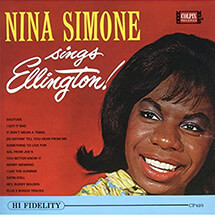
SINGS ELLINGTON (2005)
Additions: Come On Back Jack; Nobody Knows You When You're Down And Out; I Want A Little Sugar In My Bowl; Since My Love Has Gone; If Only For Tonight
- Trouble In Mind
- Memphis In June
- Cotton Eyed Joe
- Work Song
- Forbidden Fruit
- Little Liza Jane
- Rags and Old Iron
- You Can Have Him
- Just Say I Love Him
- Nina Simone – vocals, piano, arrangements
- Al Schackman – guitar
- Chris White – bass
- Bobby Hamilton – drums
Recording session: New York City – various dates
Catalog number: CP 443 / SCP 443
Track source info:
- Trouble In Mind — live recording from At Newport (1960)
- Memphis In June — from Forbidden Fruit (1960)
- Cotton Eyed Joe — from At Town Hall (1959)
- Work Song — from Forbidden Fruit (1960)
- Little Liza Jane — live recording from At Newport (1960)
- Rags and Old Iron — from Forbidden Fruit (1960)
- You Can Have Him — live recording from At Town Hall (1959)
- Just Say I Love Him — from Forbidden Fruit (1960)
Liner notes:
“Nina’s Choice” presents the multi-talented artist Nina Simone in an album of expressive vocal and piano interpretations. She personally has chosen to bring you a fine assortment of traditional and newer folk music, blues, and pop standards.
She shows distinctive versatility in her mastery of music of all kinds. Regardless of the size of her supporting group, her own sound is always dominant.
Her treatment of the faster numbers displays her complete conception of rhythm, while the more tender songs give evidence of her warm understanding of the balled.
Her area of expression continues to expand and within any field that she elects to explore, her choice produces results that are always imaginative, listenable, and thoroughly appealing.
- Don’t Let Me Be Misunderstood
- Night Song
- The Laziest Gal In Town
- Something Wonderful
- Don’t Take All Night
- Nobody
- I Am Blessed
- Of This I’m Sure
- See-Line Woman
- Our Love (Will See Us Through)
- How Can I
- The Last Rose Of Summer
- Nina Simone – vocals, piano, arrangements
- Rudy Stevenson – flute
- Lisle Atkinson – percussion
- Bobby Hamilton – drums
- Horace Ott – arranger, conductor
- Hal Mooney – arranger, conductor, producer
Recording session: New York City – 1964
Catalog number: PHS 600-148 / PHM 200-148
Liner notes:
In the late fifties, Nina Simone made such a profound debut in the jazz field that the label “jazz singer” threatened to bind in her infinite and many-faceted talent.
Now, this album sets the record straight with a varied repertoire ranging from blues and ballads to Broadway melodies. Still dramatic, still outspoken and somewhat controversial, Nina is, today, much more than just a jazz songstress. And if her style still leans toward the take-it-or-leave-it, that attitude is purely academic.
For who could be so insensitive as to “leave it” when Nina is performing a fine blues number like “Nobody” or the free and easy Cole Porter paean to “The Laziest Gal in Town,” or even a bit of bygone-day romanticism, “The Last Rose of Summer,” performed indulgently proper and straight? Nina Simone is versatile. We could say it over and over again, but why? This album says it so much more eloquently.
The one and only Nina Simone, a tribute by Langston Hughes:
She is strange. So are the plays of Brendan Behan, Jean Genet, LeRoi Jones, and Bertold Brecht.
She is far out, and at the same time common. So are raw eggs in Worcestershire and the CONNECTION.
She is different. So was Billie Holiday, St. Francis, and John Donne. So is Mort Sahl. So is Willie Mays.
She is a club member, a colored girl, an Afro-American, a homey from Down Home. She has hit the Big Town, the big towns, the LP discs and the TV shows– and she is still from down home. She did it mostly all by herself. Her name is Nina Simone.
She has a flair, but no air. She has class, but does not wear it on her shoulders. Only chips. She is unique. You either like her or you don’t. If you don’t, you won’t. If you do–wheee-ouuu-eu! You do!
Some folks never did learn to like Billie Holiday. Some folks don’t like Eartha Kitt. To some Edith Piaf never meant peanuts. To others Mabel Mercer could come for free, and Jackie Mabley is not worth a dime. Bert Williams maybe drug your mama and Val ida Snow your papa. Tastes differ. For some tastes Ethel Waters was and Pearl Bailey is, Bing Crosby was and Frank Sinatra is, George Walker was and Sammy Davis is. But Elvis, No! Ornette Coleman, not Barbara Dane, not Jacob Lawrence, never! And don’ t mention Lotte Lenya.
Everybody has a right to like whoever he likes and whatever he likes in life and in the arts. Some folks in religion like the Rev. Howard Thurman, some like Father Divine, others prefer Benjamin Mays and some Mother Horne. In literature many read Frank Yerby and some read James Baldwin.
In politics some like Goldwater and some like Nasser. In food some like chitterlings, some caviar.
In entertainment some like Nipsey Russell, some like Charles Aznavour, some like Dorothy Donegan, and some like Nina Simone.
Why should anyone like her because she plays piano well? So do lots of other people. But she plays piano FLUIDLY well, SIMPLY well, COMPLICATEDLY well, THEATRICALLY well, DRAMATICALLY well, INDIVIDUALLY well, and MADLY well. Not just WELL.
Why should one like Nina Simone because she sings a song differently? Plenty of singers sing songs differently. But many singers strain so hard to be different, pay arrangers so much money to make their songs sound different, but have no convictions themselves about what they are singing, and so seem hollow, artificial, fake, and wrong when they sing a song. Nina Simone is as different as beer is from champagne, crackers from crepes suzettes, Eastland from Adam Powell, Houston from Paris– each real i n their way, but Oh! how different– and how fake it is if it is not Houston you want but the “city of light.”
The letters l-i-v-e that spell LIVE mean exactly the same as the letters N-i-n-a that spell NINA. As for that word SIMONE—be cool, Jack, be cool! And listen to this album.
ALTERNATE COVERS:

ABRIDGED VERSIONS:

EXPANDED EDITIONS:
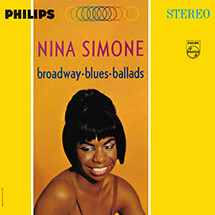
BROADWAY - BLUES - BALLADS (2006)
Additions: A Monster
- I Put A Spell On You
- Tomorrow Is My Turn
- Ne Me Quitte Pas
- Marriage Is For Old Folks
- July Tree
- Gimme Some
- Feeling Good
- One September Day
- Blues On Purpose
- Beautiful Land
- You’ve Got To Learn
- Take Care Of Business
- Nina Simone – vocals, piano, arrangements
- Rudy Stevenson – guitar
- Horace Ott – arranger, conductor
- Hal Mooney – arranger, conductor, producer
- Roger Short – liner notes
Recording session: New York City – 1964-1965
Catalog number: PHS 600-172 / PHM 200-172
Liner notes:
The spell that Nina Simone casts in her songs is completely unique, something that is her own very personal form of expression. It may be touching, it may be gay, it may build a searing flame of anger. But it is always a true emotion that her spell evokes. It is an honest and very human emotion because it is built on the unfailing integrity of this remarkable artist.
When she sings a song, she means it. And you always know that she means it. She means the loving tenderness you’ll hear in “One September Day,” she means the lusty exuberance of “Gimme Some,” and she means the desolation of “Ne Me Quitte Pas.” She chose these songs and all the rest of the tunes in this album because they are songs that have both meaningful lyrics and meaningful music. She calls them “heavy” songs—which does not mean they are difficult but that they are not to be taken lightly. They are songs that demand to be listened to.
For instance, the title song, “I Put A Spell On You,” it is, she points out, “the kind of a song that no one can ignore.” She first heard it about ten years ago when it was recorded by Screamin’ Jay Hawkins. Listening to Hawkins’ strong, often outlandishly weird presentation was one of the most moving listening experiences she has ever gone through. She has chosen to set it against a ballad background but even in these circumstances it gives her an unusual opportunity to cut completely loose.
“Ne Me Quitte Pas,” written by the French singer, Jacques Brel, is about a young couple who are inseparable until the girl does something that is completely unforgivable. The boy is going to leave her but she says that if he leaves, she will die—literally. And so she tells him all the things that she will do to get him to stay—“I will be the shadow of your shadow,” she says, “and if that is not enough, I will be the shadow of your dog.”
Two of the songs are from Anthony Newley’s new Broadway show, The Roar of the Greasepaint—The Smell of the Crowd. “Beautiful Land” brings out that part of Nina Simone’s personality which still reflects the sincere simplicity of a little girl. “Feeling Good,” which cries the joys of acceptance as a human being, is sung in the show by Gilbert Price whose manager, Andrew Stroud, happens coincidentally to manage Miss Simone.
Charles Aznavour, the perceptive French singer and composer, created two selections—“You’ve Got To Learn” and “Tomorrow Is My Turn”—both of which have the kind of explicit, meaningful lyrics that Miss Simone particularly relishes. And there is a contrasting pair of works by her guitarist, Rudy Stevenson. One is the gently evocative “One September Day” which, says Miss Simone, “reminds me of the way I used to sing many years ago, soft and sweet and very simple.” The other goes to an opposite extreme—the finger-snapping instrumental, “Blues On Purpose.”
And let’s not forget the open, honest, down-to-earth Nina. She takes over on “Gimme Some,” a lusty song with a forthright attitude that she admires because, she declares, “we need somebody not to make fun of sex but to praise it.”
ALTERNATE COVERS:

- Be My Husband
- Nobody Knows You When You’re Down and Out
- End of the Line
- Trouble In Mind
- Tell Me More and More and Then Some
- Chilly Winds Don’t Blow
- Ain’t No Use
- Strange Fruit
- Sinnerman
- Nina Simone – vocals, piano, arrangements
- Al Schackman – guitar, harmonica
- Rudy Stevenson – guitar, flute
- Lisle Atkinson – double bass
- Bobby Hamilton – drums
- Hal Mooney – producer
- Douglas McCelland – liner notes
- Maurice Seymour – photography
Recording session: New York City – March 1964-May 1965
Catalog number: PHS 600-187 / PHM 200-187
Liner notes:
“Pastel Blues”—a very pretty title for an album, and this one is about blues; but perhaps the “Pastel” part may be a bit misleading. According to Mr. Webster, pastel means “a pale and light shade of color.” There is nothing very pale or light about this extraordinary Philips Records LP performance from the incomparable Nina Simone.
Rather, it is a dynamic album introduction to the blues for the artist in which Nina evokes all the windswept grandeur of classic Greek tragedy on a selection of nine pieces that, in the startling dramatic Simone interpretations, reverberate against the rock of memory long after their sound stills. For Nina Simone is more than just a singer, more than just a pianist, more that just a musician, even. She is a painter of moods, emotions, more often than not dark moods and emotions, the kind that give dimension to a human being and the depth and wisdom of the ages to a recording.
Sometimes her moods are shocking, as in the “Strange Fruit” band, perhaps the most overwhelming example of Nina’s dramatic as well as musical gifts in this package. Singing, or moaning, or wailing, or crying out about the horrors perpetrated in the modern South, Nina starts out on the selection as a woman numb with what she has seen, and smelled—“Blood on the leaves and blood at the roots,” “black bodies swinging from the trees,” “burning flesh”—and finishes with a chilling, stirring emotionalism that etches all the injustices of man to man, leaves them indelibly written on the wind. It is a tour de force performance, and is Nina’s only real tussle with The Problem on the album.
The rest of the material is mostly man vs. woman blues, and Nina proves she has the master’s feel.
“Be My Husband” is another very dramatic offering, as Nina cracks a mighty whip and commands her “daddy” to love her good. From this she moves to “Nobody Wants You When You’re Down and Out,” on which—aided by a deft, just right backing, which is true of all the bands—she is in a more conventionally bluesy frame of mind. This gal may say she’s down and out, but somehow you don’t feel it’s for good. The girl of “The End of the Line,” however, is a more sensitive, almost gloomy soul, and her moroseness is no mere passing mood. As Nina movingly paints her, it is truly the end of the line for this lady, and the listener knows it and empathizes.
Nina’s versatility is shining brightly—even when confined to a blues formal—by the the Band No. 4 rolls around. It’s “Trouble In Mind,” and now the man-moaning is in a more optimistic vein. This woman’s going to be all right. “The sun’s gonna shine in my back door someday”; and although she’s “goin’ down to the riv-ah,” she’ll be back, as Nina so eloquently conveys the message.
“Tell Me More and More and Then Some,” is extremely sensual, and, as Nina performs it, has a kind of languid, dreamlike quality as she tells about her man troubles—all worth the trouble, she decides. Suddenly, “Chilly Winds” blow, and it’s too much for Nina’s gal—she’s moving on to where there’ll be “red roses ‘round my door.”
On “Ain’t No Use,” Nina smartly handles a more contemporary blues offering and makes vinegary use of such popular catch phrases as “leaving’ the scene,” “putting you down,” etc to delineate the age-old problem of an ill-treated lover who has the feeling that she wants to go, but can’t.
The longest band on “Pastel Blues” is the gospel-tinged “Sinnerman,” with Nina magnificently catching the hysteria of a soul lost. It is a bang-up finale to an album that vividly demonstrates the wide range of talent that is Nina Simone’s. There must be someone who can adapt “Electra” or “Antigone” or “The Trojan Woman” to the musical idiom for Nina. Hers is a roaring, brooding, craggy, commanding talent that would be eminently at home in this classically tragic milieu.
ALTERNATE COVERS:

- Mood Indigo
- The Other Woman
- Love Me Or Leave Me
- Don’t Explain
- Little Girl Blue
- Chauffeur
- For Myself
- The Ballad of Hollis Brown
- This Year’s Kisses
- Images
- Nearer Blessed Lord
- Nina Simone – vocals, piano
- Rudy Stevenson – guitar, flute
- Lisle Atkinson – bass
- Bobby Hamilton – drums
- Horace Ott – arranger, conductor
- Hal Mooney – producer
- Charles Champlin – liner notes
- Maurice Seymour – photography
- Don Bronstein – photography
Recording session: New York City – October 1965; Live at Carnegie Hall – 1964 (Images)
Catalog number: PHS 600-202 / PHM 200-202
Liner notes:
On her personal odyssey from hart-time rural North Carolina to big-time big city acclaim, Nina Simone has been exposed to gospel, country blues, classical training, jazz plain and progressive, the glossy ballad and big band scenes, right up to the discotheque and Dylan.
All of these musical strands show up in her work, and on this album. Yet, like an alloy which becomes a shining thing different from any of its pure components, the Nina Simone sound becomes something uniquely her own—fused, you might say, by her powerful and sensitive personality.
I can think of no singer who would have attempted the musical and emotional range represented here. No one else, I’m sure, would have brought it off. Her hypnotic, riveting effect on audience is by now legend. It comes through here, even though we can’t watch her rapt dialogue with her piano or see her beautifully soulful face spotlighted as she sings with shattering intensity about bad times or unfaithful males.
For openers, try “Images,” a poem by W. Cuney, Nina heard on a record and gave a melody, which she sings unaccompanied. “Little Girl Blue” displays the fresh poignance Nina can find in a standard, just as another standard,“Love Me Or Leave Me,” lets you know what a swinging jazz talent she is. Her extended piano chorus on that one turns nicely Bach-is and reminds you of her Juilliard days.
“The Other Woman” is a quiet essay in sad truth. “Mood Indigo” is a surprise, taken at a striding uptempo that gives Nina a fine keyboard romp. “Don’t Explain” is, of course, Billie Holiday’s forgiveness to a philandering man, and if anybody today matches Billie’s emotional voltage in song, it is Nina.
“Chauffeur” is a traditional shouting blues, which Nina first heard Big Mama Thorton do. Nina’s husband, Andy Stroud, did this adaptation for her.
Her version of Bob Dylan’s “The Ballad of Hollis Brown,” with its insistent, doom-haunted accompaniment, suggest again that Dylan is a powerful writer, but by no means his own best interpreter.
Nina added Irving Berlin’s oldie, “This Year’s Crop of Kisses” to her repertoire after she’d heard a Billie Holiday recording of it. The lyric somehow acquires a dimension even the composer had thought was there.
“For Myself” is a lovely new ballad by Van McCoy, a young songwriter who is a fan of Nina’s.
In “Nearer Blessed Lord,” Nina evokes her own musical beginnings, as a pre-teen pianist in her country church in North Carolina. Husband Andy Stroud adapted the traditional hymn, which Nina sings traditional revival style.
Accompanying Nina at the sessions and at the concert where “Images” was recorded live were her regular trio, Lisle Atkinson on bass, Robert Hamilton on drums, and Rudy Stevenson on guitar and flute.
The album title seems just right, Nina holds nothing back and she fakes nothing. Perhaps the greatest of her many gifts is the gift of intensity.
ALTERNATE COVERS:

- I Loves You, Porgy
- Blackbird
- Falling In Love Again (Can’t Help It)
- Baubles Bangles and Beads
- Spring Is Here
- That’s All
- Work Song
- The Man With A Horn
- Porgy I Is Your Woman Now
- Gimme A Pigfoot (And A Bottle Of Beer)
- Nina Simone – vocals, piano, arrangements
Recording session: New York City – 1961-1964
Catalog number: CPL 496 / SCP 496
Liner notes:
Nina Simone has been the subject of countless accolades. She has, over the years, become one of the best known interpreters of songs, both on records and well as in other mediums. She is equally at home on the concert state as she is in the darkened shadows of a smokey night club.
Nina Simone is many things, but she has always been first, a superb musician. Her piano and her voice give evidence to this. She is a musician with a complete understanding of both the lyric, as well as the melodic content of a song. She is a musician who can evoke any mood with any given song. Her repertoire ranges from blues, to folk, to semi-classical t0 gospel. She is everything that she needs to be to make a song ring true, to make it an emotional experience for both herself and the listener.
For the record, the musician was born in Tryon, North Carolina, the product of musical parents and one of eight children. Her musical activities began with the piano at the age of four. Later Nina sang spirituals in her local church choir. By the time Nina reached high school, her singing was already influenced by Marian Anderson and her jazz piano by the Nego folk blues of the South. At 17, Nina moved on to Philadelphia where she earned her keep teaching piano and then accompanying a variety of pop singers. She also continued her own studies with two years at Juilliard School of Music.
So much for past history. The real history of Nina Simone is being made every time she sits down ate the piano. The real story is the way she works the songs in this new collection.
In this album, Nina’s piano and voice is given a warm, flowing string accompaniment. It eloquently complements Nina’s approach to the songs included in this set. The strings follow Nina, never imposting or distracting from her phrasing, her timing, or her instinctive “feel” for the song. She runs the gamut of emotions throughout this recording. She is with one number, light, gay, off-handed, with the next romantic and loving and with still another sad, wistful and intense. Included in her selections is her classic rendition of Gershwin’s “I Loves You Porgy.”
This is Nina Simone in a rare performance, a performance filled with magnificent moments. This is Nina Simone the vocalist, Nina Simone the pianist, but most of all Nina Simone the musician.
- I Love Your Lovin’ Ways
- Four Women
- What More Can I Say
- Lilac Wine
- That’s All I Ask
- Break Down and Let It All Out
- Why Keep On Breaking My Heart
- Wild Is The Wind
- Black Is The Color Of My True Love’s Hair
- If I Should Lose You
- Either Way I Lose
- Nina Simone – vocals, piano, arrangements
- Lisle Atkinson – bass, upright bass
- Bobby Hamilton – drums
- Rudy Stevenson – flute, guitar
- Horace Ott – arranger, composter, conductor
- Hal Mooney – producer
- Sid Mark – liner notes
- Sherniece Smith – art production
- Kazumi Matsumoto – design
Recording session: New York City – March 21, 1964-October 1, 1965
Catalog number: PHS 600-207 / PHM 200-207
Liner notes:
“FORGET IT KID—IT’S A LOCAL RUMBLE.” And the phone came down without another word. The night before, Nina came to me with the first pressing of her new, and then only, album. We did our interview with more than the usual DJ-Artist relationship, as Nina and I had been paying our dues together in Philadelphia for many years. She, playing in a small club trying to prove that the talent we believed in was there, and I, trying to prove that jazz could be commercially acceptable on a twenty-four hour basis on Radio.
The audience, responding with a tremendous volume of phone calls, insisted—or rather demanded—that we replay one track—PORGY—and we did, time and time again. With Nina’s permission, I called the record company to report what had happened…the voice at the other end then retorted those now famous words…
“FORGET IT KID—IT’S A LOCAL RUMBLE”
Needless to say the “local rumble” sold well over a million, and since that time (late in 1957) Nina has become not only an established name in the jazz vocal scene, but also can be classified as a “truly great entertainer.”
Nina recently made a special visit to be a guest on my weekly TV show—“The Mark of Jazz”—and the best gauge on an artist’s popularity is how many station personnel filter into the studio—there was little or no room for the crew—and the next day an interoffice memo requested that at least one person should have reminded on the switchboard—a true tribute from management.
Nina’s performance on the show was fantastic: she sang, she played, danced, and above all, was Nina Simone. The response was so good that we are now planning a one-hour special, “A Night With Nina” to be aired very shortly.
The reason I make no mention of the contents on this album is that the advance pressing was damaged in the mail—but in conversation with Nina’s husband/manager Andy Stroud—I asked if it would be permissible to tell our little story. Thus it is with Nina, who has proved what she set out to do in the winter of 1957—and while we may not remember the snow that fell that season, we in Philadelphia and around the country still recall the effects of a tremendous “LOCAL RUMBLE.”
ALTERNATE COVERS:

- Don’t You Pay Them No Mind
- I’m Gonna Leave You
- Brown Eyed Handsome Man
- Keeper of the Flame
- The Gal From Joe’s
- Take Me To The Water
- I’m Going Back Home
- I Hold No Grudge
- Come Ye
- He Ain’t Comin’ Home No More
- Work Song
- I Love My Baby
- Nina Simone – vocals, piano, arrangements
- Hal Mooney – arranger, producer
- Jack McMahon – editing
- Del Shields – liner notes
Recording session: New York City – 1965-1966
Catalog number: PHS 600-219 / PHM 200-219
Liner notes:
Most of it has been said before. Much of it has been repeated in more was that this writer would dare attempt. The story is very simple.
Nina Simone is an artist of tremendous magnitude. She possesses the ability to strip you of whatever preconceived ideas you had and compel you you to listen to her. Like her or not, one reliable reporter essayed that “listening to Nina Simone and seeing her perform is an experience you are not likely to forget.”
Unfortunately the art world finds itself constantly in conflict with the world of commercialism. And within the commercial world where monetary gauges are the balance of power, we find it necessary to make comparisons.
In attempting to compare Nina there are few peers. She is an uncompromising artist who holds no fear in challenging new and different material. If there is an insecurity, it is her deep desire to communicate and her wish for her audience to relate to the material she performs.
And when she is unable to communicate it is here that the frustration develops. She does not become defensive upon discovering that the communication has not been what it should have been. She insists upon trying again and again, ever cognizant of the need to transfer her feeling and interpretation to the audience and almost bare her soul hoping you, the audience, will see, hear, and understand.
Nina Simone does not seek the easy way. A review of the material she has recorded during the decade of her recording career will attest to this. Her way has been using much original material well identified with out artists, and rarely translated by others.
There have been the folk, jazz, country, gospel, blues, ballads, and tunes of simple faith and narratives of slices from life. Within these songs, Nina has been the artist and the commentator. She has painted the picture and she has reported the events.
Through her illustrious career, she has reached a segment of the music-loving public who have the infinite ability to know and recognize a true artist.
For who could give us “Mississippi Goddam” and “Four Women” and tear us apart with the hard realities of the stories these tunes contain. Who could sketch the sad and poignant story of “The Other Woman” and “Little Girl Blue.” None but a “High Priestess of Soul.” In this newest album, Nina adds a collection of new songs and others done over in her personal and magnetic style.
There is nothing superficial about Nina Simone. There is no fakery. There is no planned premise that given the right amount of exposure and the right tunes will deliver a certain portion of the record buying public. Nina is simply a tremendously talented artist who has integrity and conviction.
From “Brown Eyed Handsome Man” by Chuck Berry to Rudy Stevenson’s “I’m Going Back Home” and “I’m Gonna Leave You”, “Keeper of the Flame” by Charles Derringer, Bobby Scotts (of “Taste of Honey fame) “Don’t You Pay Them No Mind,” husband Andy Stroud’s “I Love My Baby” and Duke Ellington’s “The Gal From Joes” are classic examples of Miss Simone at her best.
Those of us who are Nina Simone Fans know that in her we have become partners in a living experience of an artist who says, “share with me the feelings of love and disappointment, walk with me along the road of life that is filled with blues but celebrate also with me those few and treasured moments that makes life almost bearable, but do not turn from me when the chips are down, for this is life also. For as an artist, I must give of myself wholly and completely to the expression of that which is within.”
Nina does this again and again. And again in this album, the “High Priestess of Soul” again gives.
ALTERNATE COVERS:

ABRIDGED VERSIONS:

- Do I Move You
- Day and Night
- In The Dark
- Real Real
- My Man’s Gone Now
- Backlash Blues
- I Want A Little Sugar In My Bowl
- Buck
- Since I Fell For You
- The House of the Rising Sun
- Blues For Mama
- Nina Simone – vocals, piano
- Bob Bushnell – bass
- Bernard Purdie – drums
- Eric Gale – guitar
- Rudy Stevenson – guitar
- Ernie Hayes – organ
- Buddy Lucas – tenor saxophone, harmonica
- Mickey Crofford – engineer
- Danny Davis – producer
- David Hollander – photography
- Sid McCoy – liner notes
Recording session: New York City – RCA Studio B on 12/19/66, 12/22/66, and 1/5/67
Catalog number: LMP-3789 / LSP-3789
Liner notes:
Creative people are, in the main, individualists, and in our business—jazz and its related offshoots—there seems to be a direct relation between creative ability and the determination to “be myself.” Nina Simone is an individualist of the highest sort.
Here she is, a tremendous artist accurately reproducing native blues in a most compelling fashion. There are no mannerisms. Affection never enters the picture. There is no hiding behind big bands, studied arrangements, or audio effects. Miss Simone simply sings—with heart at times, with guts on certain tunes, and with abandon on everything. She has wisely kept accompaniment to the small unit, which provides her with an authentic cushion of rhythm and impetus. The musicians merely echo the emotion and inflection of the artist.
These tunes are not the ones we hear on the top forty, nor are they sung by the dilettante jazz singer who does a novelty blues album. They are songs of the soil, of the people and of their troubles.
Here Miss Simone enters that world briefly, but her admission was earned and she has not violated the essence of either the people or the music. What we have here is an acceptable artist really giving it to us about the most unacceptable pangs of life.
She really moves on Do I Move You? Hear her ask the question with that peculiar mixture of humility and saucy arrogance. Day and Night is another free roller.
The old-timers who undulated on the wartime dance floors during the forties will instantly remember the slow-moving In The Dark. Listen to Miss Simone’s treatment and reminisce a little.
Real Real is a free, secular adaptation of a foot-stomping ole spiritual He’s So Real To Me. The matter is the same. The tempo is unchanged and Miss Simone builds to a fevered pitch.
The music of “Porgy and Bess” often finds its way into the repertoire of the jazz artist. My Man’s Gone Now is one of the plaintive melodies that taxes the emotional capacity of the best vocalists. Miss Simone adds to its impact by handling the tune with simplicity and feeling.
Nina Simone would not be Nina without her moments of magnificent outrage and passionate protest. Hear Backlash Blues. It’s a scathing, heated comment on the socio-political times in which we toil.
I Want a Little Sugar In My Bowl is one of those suggestive tunes successfully employing double-entendre. The most commonplace practice of early blues has lost much of its originality over the years. Miss Simone harks back to Bessie Smith and early Dinah Washington, two of the most proficient vocalists at this game.
Buck is the shortest tune in the album, but in many ways the most powerful. It is a man’s name, an animal, a sound, a veritable explosion.
If you remember In The Dark, you’ll remember Since I Fell For You. Not since Bull Moose’s poignant howling has this old tune sounded so mellow.
Some may believe The House of the Rising Sun is a ringer here. Be cool and listen again. The spirited tune with flying rhythms holds a kind of magnetic charm. It crackles with the mysticism and compulsion of blind faith and true believing. Miss Simone takes her time here to build the spell.
Every artist is entitled to one for herself. Blues For Mama has to be it. Mama is Nina and Nina is Mama—singer of the blues.
ALTERNATE COVERS:

EXPANDED EDITIONS:
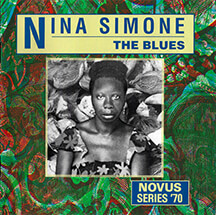
THE BLUES (1991)
Additions: The Pusher; Turn Me On; Nobody’s Fault But Mine; Go To Hell; I Shall Be Released; Gin House Blues
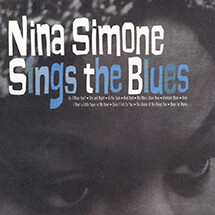
SINGS THE BLUES (2006)
Additions: Do I Move You (second version); Whatever I Am You Made Me
- It Be’s That Way Sometimes
- The Look of Love
- Go To Hell
- Love O’ Love
- Cherish
- I Wish I Knew How It Would Feel To Be Free
- Turn Me On
- Turning Point
- Some Say
- Consummation
- Nina Simone – vocals, piano
- Gene Taylor – bass
- Bernard Purdie – drums
- Eric Gale – guitar
- Rudy Stevenson – guitar
- Ernie Hayes – piano, harpsichord
- Danny Davis – producer
- Sammy Lowe – arrangements, conductor
- Ray Hall – engineer
- Del Shields – liner notes
Recording session: New York City – RCA Studio B
Catalog number: LMP-3837 / LSP-3837
Liner notes:
Make no mistake, Miss Nina Simone is one of the greatest exponents of American “soul” music. She has already been given the title “High Priestess of Soul.” This tribute is not one she personally relishes, nor did she campaign for it. It was awarded to her since there were few critics who could adequately describe her plea to “hear my message.”
It is incongruous to attempt to categorize her. She defies any of the limpid classifications we apply to purveyors of song. She is neither all jazz nor all pop; neither all soul nor all R&B. She is neither all folk nor all folk protest; neither poetess nor balladeer. She is simply Nina Simone, a voice in this wilderness of modernity and industrialized society which cries out to be heard.
She feels the story must be told. She strongly feels that truth is the real yardstick for humanity’s survival. And she loves her fellowman.
Therefore it is reasonable to say that Nina is the sum total of “the artist” who will neither compromise nor plagiarize.
It is strange in our day for an artist like Nina to still exercise the right to perform songs of truth in her inimitable style and communicate to the audience without loss of integrity.
But this is Nina.
Why fight the establishment, the say? Why take the difficult road? There is no hope for those who wish to carve their own route. Give up and join. Play it safe.
These warnings have little effect on Nina Simone, for she is unable to sing a song without thinking of its meaning and what it represents to her audience.
But she is not alone. She is proud possessor of an increasing and dedicated following of people who support her in concerts and at her in-person appearances at clubs across the country.
Songwriters who wrote songs with a message, because they feel that survival is based on truth, seek her out. And she records their material. Many times she has suffered the banishment of her tunes by the archaic censors who fear to upset the establishment. On occasion she has become the center of controversy because she demands first-rate conditions in order to perform at her maximum degree of excellence for her audience.
And this is Nina.
Silk and Soul is the follow-up to her debut album on RCA Victor, Nina Simone Sings The Blues. Here again she has taken songs and shaped them in her particular mold. The result is another example of superb magnificence that befits a “High Priestess of Soul.”
She has successfully woven a group of tunes into a specter of silky but soulful interpretations that are far above the commercialism that is designed purely for the hit charts. Yet they will make the charts devoid of such commercialism since they stand on their own merits. They are minute musical chapters of the philosophy of Nina Simone embroidered and embellished by melody.
Consummation, a beautiful love song based on a Bachian figure, reveals the tenderness of Nina’s soul. She wrote the music and the words.
Nina’s husband and manager, Andy Stroud, who has displayed a talent for songwriting that lends to her personal elucidations of tunes, wrote Love o’ Love based on the familiar Careless Love structure of a few seasons ago.
Morris Bailey—a talented musician-lyricist from Philadelphia and a brother of Donald Bailey who spent a number of years as a percussionist with jazzdom’s number one organist, Jimmy Smith—wrote Go To Hell which carries a strong moral and religious theme.
Sam Waymon, Nina’s brother, penned It Be’s That Way Sometime.
Billy Taylor, the leading jazz disc jockey in New York whose pianistic talents have always been honored, wrote I Wish I Knew How It Would Feel To Be Free.
Burt Bacharach, whose musical accomplishments enabled Miss Dionne Warwick to become a top-selling artist, wrote The Look of Love from the super star motion picture “Casino Royale.”
Cherish, Some Say, Turn Me On, and Turning Point complete the album. They are additional examples of the manner in which Nina can take a tune and capture the complete essence of the writer’s spiritual and melodic message.
Miss Nina Simone is a member of the establishment which is concerned about the need to convey truth to the audience. She is indeed an artist of tremendous magnitude. As you listen to this album you will become completely involved in the music while you absorb the essential quality of truth to be found here.
ALTERNATE COVERS:

EXPANDED EDITIONS:
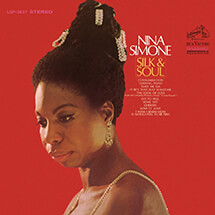
SILK & SOUL (2006)
Additions: Why Must Your Love Well Be So Dry; Save Me
- Seems I’m Never Tired Lovin’ You
- Nobody’s Fault But Mine
- I Think It’s Gonna Rain Today
- Everyone’s Gone To The Moon
- Compensation
- Who Am I
- Another Spring
- I Get Along Without You Very Well (Except Sometimes)
- The Desperate Ones
- Nina Simone – vocals, piano, arrangements
- Ray Hall – engineer
- Joseph Dylewski – photography
- Tom Reed – liner notes
Recording session: New York City – RCA Studios – September 16 & October 1, 1968
Catalog number: LSP-4102
Liner notes:
This album is a first for Nina Simone. It features Nina accompanying herself at the keyboard. There is one instance of overdubbing the organ and some others of dubbing her voice and of clapping and tambourines, but in this album everything is done solely by Nina Simone with no outside help.
The product here is “pure” Nina. Always pertinent, persuasive, and exciting, this great artist has the lusty, lyrical, and explosive power to ignite audiences of all races. Her message is that of life on this earth. THE TRUTH.
The impact here is individual, for Nina treats each song differently, and each complements the other. Nina is a strong but dedicated woman—dedicated to turning her listeners “on” and continually demonstrating her boundless creative talents.
It has been said by many music critics that Nina is the most emotional songstress in the world today. Her total involvement will encase one person’s mind while, on the other hand, she might infuriate another. Yes, Nina Simone doesn’t play games—she plays piano and sings. Let’s listen!
Blues, soul, and all the musical connotations that magnify the musical ability of black artists are apparent in Nina’s rendition of Seems I’m Never Tired Lovin’ You. The black spiritual Nobody’s Fault But Mine, which is now a standard, adds to the total color of the album.
As we continue, Nina’s vast background in life’s changes furthers her individualism in each song she sings. Like all of us, she has experienced her share of life’s sorrows, disappointments, happiness, and bitterness. Nina has tasted life, and this is what she sings about. This is particularly noticeable on I Think It’s Going To Rain Today and Everyone’s Gone To The Moon. The latter song is indeed apropos in light of the recent Apollo 7 flight. In closing Side 1 of this remarkable album, Nina takes off on a poem written by black poet Paul Lawrence Dunbar. It’s called Compensation.
Who Am I and Another Spring present a stirring emotional setting guided by an intelligent train of musical thought. Note the gospel roots of black life in Another Spring. Nina’s ballad style is evident on the informative and poetic The Human Touch. She treats the evergreen I Get Along Without You Very Well with tender expressiveness.
The Desperate Ones is an English translation of one of the outstanding Jacques Brel compositions currently being featured in the off-Broadway hit musical “Jacques Brel Is Alive and Well and Living In Paris.” Nina’s a gas here…
That’s it. Now you have it—the most enjoyable musical presentation I’ve ever heard.
“Nina Simone and Piano” is stylish, subtle, inventive, soulful, and…”pure.”
ALTERNATE COVERS:

EXPANDED EDITIONS:
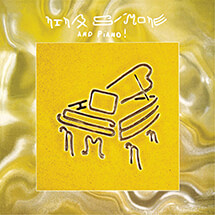
NINA AND PIANO (2003)
Additions: Music For Lovers; In Love In Vain; I'll Look Around; The Man With The Horn
- Suzanne
- Turn! Turn! Turn!
- Revolution, Pt. 1
- Revolution, Pt. 2
- To Love Somebody
- I Shall Be Released
- I Can’t See Nobody
- Just Like Tom Thumb’s Blues
- The Times They Are A Changin’
- Nina Simone – vocals, piano, arrangements
- Charles D. Alias – drums
- Weldon J. Irvine – organ
- Al Schackman – guitar
- Gene A. Perla – bass
- Doris Willingham – vocals
- Virdia Crawford – vocals
- Jimmy Wisner – arrangements, conductor
- Mike Moran – engineer
- Ray Hall – engineer
- Claude Hall – liner notes
Recording session: New York City – RCA Studios – 1967-1969
Catalog number: LSP-4152
Liner notes:
Many austere critics not prone to dishing out praise in anything but small dribble have lavishly compared Nina Simone to the legend of the siren of Lorelei – a woman who enchanted sailors with the magic of her voice. Nina Simone certainly does have a magical quality in her voice. She inspires one to dream, to yearn, perhaps to suffer, if the song is one of sorrow. The commanding authority of her voice compels her listeners to explore new worlds and new ideas and new ideals.
In the mansion of the mind, where a song feeds only on the nebulous winds of imagination and emotion, Nina Simone walks in musical grandeur where few others dare stray. She can be warm and tender, or she might turn into a storm of anger, boiling in the fury of the song. Yet she is so great she communicates human understanding and affection for her fellow beings even while she attacks the towers of Wrong or Prejudice lyrically.
A queen among women, she is undoubtedly one of the most accomplished musicians of our time. Her music is without frills, but highly experimental in nature. She is not afraid of breaking the artificial boundaries set by other musicians; she explores all avenues and there is a constant barrage of new musical concepts and expressions in her piano playing. The instrument comes alive. It flowers.
Her songs stand out as diamonds of perfection within a world of barren stones. For example, there’s the consuming fascination of “To Love Somebody.” It’s a song that grows on you; the more you hear it, the more you’ll want to hear it. The offbeat melodic things going on in the background cause a tingle to go up your spine. While the lyrics tell of love, Nina Simone adds the undercurrent of passion, impressing you with her vibrant dynamism and her convincing onslaught on the emotion.
A lot of her songs sparkle with jazz flavors, spiced with her delicate touches. But she doesn’t stop there. A perfect example of this is her musical methodology in the small contemporary epic “Revolution” that has all of the message of a folk song, all of the soulful emotion of an R&B hit record, yet ventures from standard musical patterns, using jazz as a stepping-stone, into a mind-exploding progressive rock ending. In this album Nina Simone uncovers an entirely new facet of the works of Bob Dylan, exploring all of the musical possibilities in “Just Like Tom Thumb Blues,” “I Shall Be Released,” and “The Times They Are A-Changing.” Under the influence of Nina Simone, “I Shall Be Released” is gospel pure and unadulterated. It thunders in the mind and the combination of piano and organ stirs the soul.
“Just Like Tom Thumb Blues” becomes a clear story, perhaps for the first time to be understood in full-depth. Nina Simone is a born storyteller in the same fashion as were the wandering minstrels who conveyed the news in King Arthur’s days. With another Dylan tune, “The Times They Are A-Changing,” she graphically dramatizes the history of our times. The song emerges as a plea for all mankind, bound to shock, bound to innervate, bound to capture not only your interest but your fire, especially when the funeralistic organ thunders down the hallway of your mind. Who but Nina Simone would have dreamed of expressing this particular song in this particular fashion – giving it new life, new meaning and new impact. With this album Nina Simone proves herself to be one of the most important performers of this age. She entertains, but, even more important, she has something to communicate.
ALTERNATE COVERS:

- Here Comes The Sun
- Just Like A Woman
- O-o-h Child
- Mr. Bojangles
- New World Coming
- Angel of the Morning
- How Long Must I Wander
- My Way
- Nina Simone – piano, vocals, arrangements
- Corky Hale – harp
- Kermit Moore – orchestra
- Howard A. Roberts – backing vocals
- Harold Wheeler – conductor, arrangements, producer
- Ed Begley – engineer
- Sam Waymon – production coordination
- Nat Shapiro – producer
- Bernie Casey – design
Recording session: New York City – RCA Victor Studio B – February, 1971
Catalog number: LSP-4536
ALTERNATE COVERS:

- Baltimore
- Everything Must Change
- The Family
- My Father
- Music For Lovers
- Rich Girl
- That’s All I Want From You
- Forget
- Balm In Gilead
- If You Pray Right
- Nina Simone – vocals, piano
- Eric Gale – guitar
- Gary King – bass
- Jim Madison – drums
- Nicky Marrero – percussion
- Al Schackman – piano (“Baltimore”)
- Jerry Friedman – guitar (“The Family” & “Rich Girl”)
- Will Lee – bass (“Rich Girl”)
- Andy Newmark – drums (“Rich Girl”)
- David Matthews – string arrangements, piano (“The Family” & “Forget”)
- Creed Taylor – producer, liner notes
- David Palmer – engineer
- White Gate – photography
- Sib Chalawick – design
String section
- Barry Finclair, Charles Libove, David Nadien, Harry Glickman, Harry Lookofsky, Herbert Sorkin, Marvin Morgenstern, Max Ellen, Richard Sortomme – violin
- Alfred Brown, Emanuel Vardi, LaMar Alsop – viola
- Alan Shulman, Charles McCracken, Jonathan Abramowitz – cello
- Chuck Israels, Homer Mensch, John Beal – double bass
Background vocals
- Albertine Robinson, Babi Floyd, Debbie McDuffie, Frank Floyd, Joshie Armstead, Maeretha Stewart, Milt Grayson, Ray Simpson
Recording session: Brussels – Studio Katy – January, 1978
Catalog number: CTI 7084
Liner notes:
I attended a Nina Simone concert at the Drury Lane Theatre in London in December, 1977. Nina played and sang to an ecstatic, packed house. It was clearly evident why her concerts have always been regarded by critics and audiences as an “experience.”
A month later, I went to Brussels to produce this Nina Simone recording. I have recorded many diverse and talented personalities over the years, but I was not prepared for the “experience” that was to follow in the recording studio.
When Nina walks into the studio, she radiates the most magnificent intensity of any artist I have ever seen. And when she begins to play and sing, she turns everything – even the most simple, mundane phrase or lyric – into a radiant, poetic message.
ALTERNATE COVERS:

- I Sing Just To Know That I’m Alive
- Fodder In Her Wings
- Vous Êtes Seuls, Mais Je Désire Être Avec Vous
- Il Y A Un Baume A Gilhead
- Heaven Belongs To You
- Liberian Calypso
- Thandewye
- I Was Just A Stupid Dog To Them
- Color Is A Beautiful Thing
- There Is No Returning/Le Peuple en Suisse
- Nina Simone – vocals, piano, tambourine, harmony vocals, arrangements, conductor
- Sylvin Marc – bass, vocals
- Paco Sery – percussion, timpani
- Sydney Thaim – congas, bells, wood block
- Daniel Abraham – engineer
- Yves Chamberlan – producer
- Giancarlo Cerri – producer
- Gabriel Jarnier – design
Recording session: Paris – Studio Davout – January, 1982
Catalog number: 67.885
Liner notes (by Patrick Frémeaux, from 2008 CD release):
Nina Simone is one of the greatest Black American artists of the 20th century. With a style set between jazz, blues, and soul, she has become a legend on par with Aretha Franklin, James Brown, Otis Redding, and Ray Charles. This is the singer’s last notable album, recorded in the Studio Davout, famous in the history of recording. Nina Simone sings in French and English with a unique rhythm, combining soul and lyricism, a unique fusion which proves her talent and identity.
ALTERNATE COVERS:

EXPANDED EDITIONS:
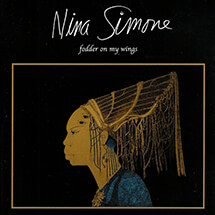
FODDER ON MY WINGS (2005)
Additions: Alone Again Naturally; Stop; They Took My Hand
- It’s Cold Out Here
- Porgy
- I Sing Just To Know That I’m Alive
- For A While
- Fodder On Her Wings
- Touching And Caring
- Saratoga
- You Must Have Another Lover
- Nina Simone – vocals, piano, arrangements
- Arthur Adams – guitar, bass
- Luke Metoyer – percussion
- Ray Brown – trumpet
- Allan Barnes – saxophone
- George Bohanon – Trombone
- The Waters Family – backing vocals
- Hense Powell – synthesizer, trumpet, cornet, arrangements
- Eddie Singleton – producer
- Jim Bailey – recording, remixing
- Janis Wilkins – design
- Von Thomas – photography
Recording session: Hollywood – Rocksteady Recording Studio; New York City – The Power Plant
Catalog number: VPI 100-7
ALTERNATE COVERS:

- A Single Woman
- Lonesome Cities
- If I Should Lose You
- The Folks Who Live On The Hill
- Love’s Been Good To Me
- Papa, Can You Hear Me
- Il N’y Pas D’amour Heureux
- Just Say I Love Him
- The More I See You
- Marry Me
- Blue Prelude
- Nina Simone – vocals, piano, arrangements
- John Chiodini – guitar
- Al Schackman – guitar
- John Clayton – bass
- Jim Hughart – bass
- Jeffrey Hamilton – drums
- Larry Bunker – percussion
- Michael Melvin – piano
- Al Schmitt – mixing, recording
- Andre Fischer – producer
- Michael Alago – executive producer
- Carol Friedman – photography
- Ntozake Shange – liner notes
Recording session: Oceanway Studios & Mad Hatter Studio – Los Angeles, California – 1993
Catalog number: 61503
Liner notes:
“With A Single Woman,” Nina Simone adds one more dimension to an already multi-faceted musical persona. No single female voice has so furiously assaulted injustice, ranging from racism to adultery, in my lifetime. Yet the songs on this album reflect a life lived with risk and integrity, humor and somber realism. The energies escaping “Mississippi Goddamn” are in these songs shaped and delicately led through primal emotional terrain, interpersonal quagmires and ravines, otherwise known as romance.
Yes, “A Single Woman” is about love, all kinds of love. Especially, a full grown woman in love. A woman in the process of defining her life, deciding her fate, accepting, without shame or guilt, her own needs and desires. With a voice, that unmistakable Simone voice, worldly, yet vulnerable, this album allows us the experiences only a strong woman survives.
Even in the title tune, “A Single Woman,” Nina Simone sings with languorous sensuality: “I’m caught in a world few people understand…I am what I am, a single woman.” Depending on how well we’ve been loved or not loved, these lyrics and the earned authority of Simone’s voice will bring hope, reassurance, or the right to grieve.
No element, no subtlety is lost on these selections. The rights and responsibilities, thrills and dissolutions of love between friends, paramours, parents and children are explored with legendary Simone dexterity and compassion.
Not unlike the mythic Charlie Parker With Strings, this album finds Nina Simone, her deep and sensate voice, nestled among arrangements featuring strings and guitars, allowing the power of her vocals to float and penetrate our realities at will.
The cavalier flirtations of “Lonesome Cities” prepare us for the whimsy of “If I Should Lose You,” just as the trio of “Papa, Can You Hear Me?” “Il N’y A Pas D’Amour Heureux” and “Just Say I Love Him” unequivocally reveal all that is tender, precious and always unprotected when we love.
“A Single Woman” is evidence that a politically conscious life my not be correct, by may be rich in moments and memories, when as Nina Simone sings, as only she can, “Love’s been good to me.”
EXPANDED EDITIONS:
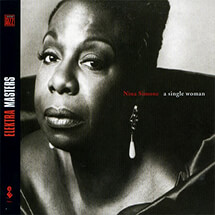
A SINGLE WOMAN (2008)
Additions: The Long and Winding Road; I'm Gonna Sit Right Down and Write Myself A Letter; Baseball Boogie; No Woman, No Cry; Do I Move You; The Times They Are A-Changin; Sign o The Times
